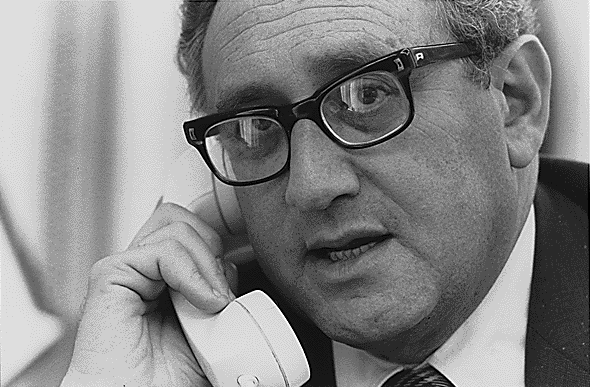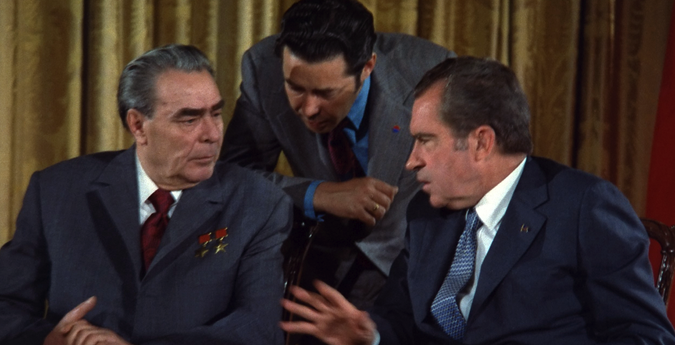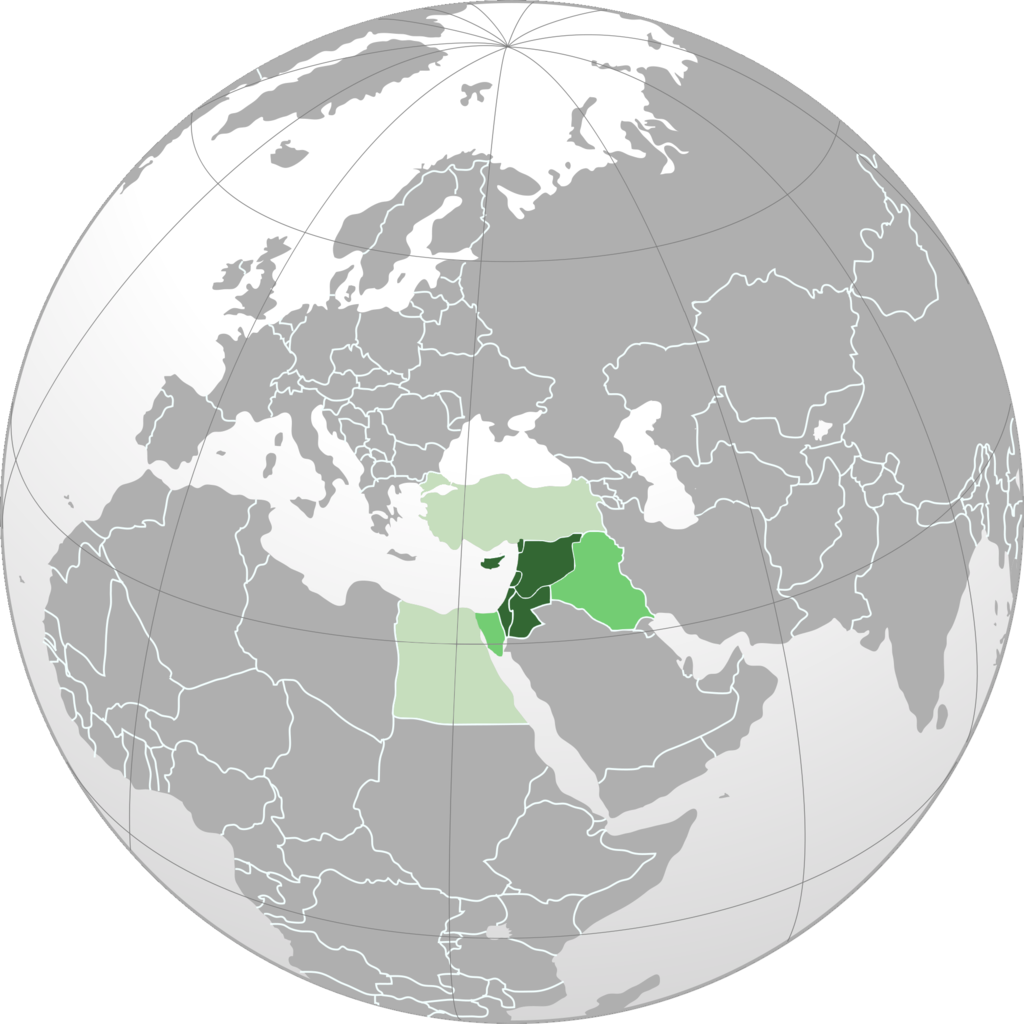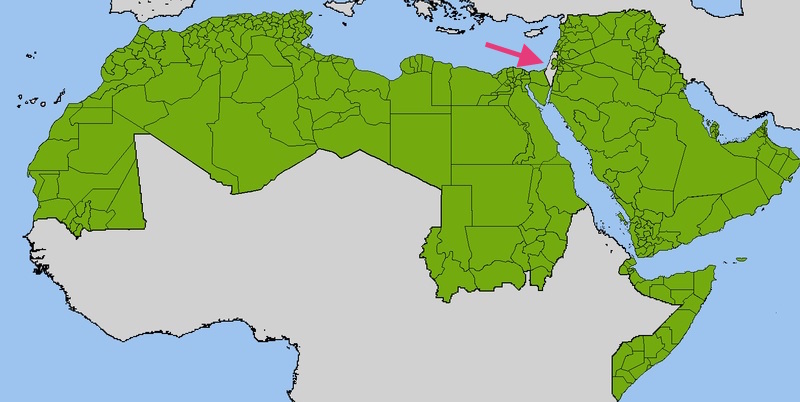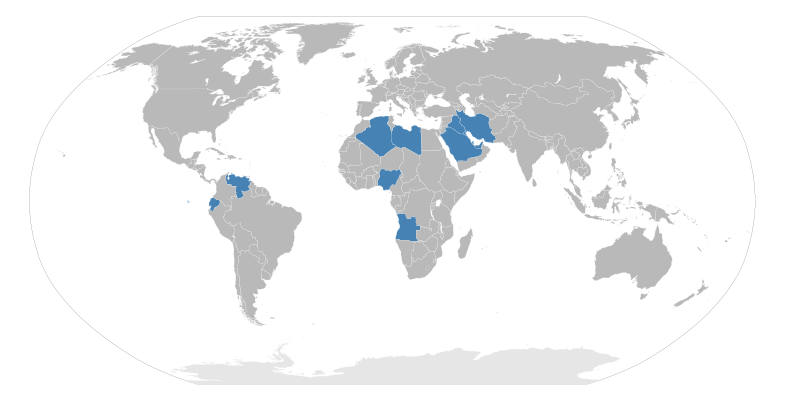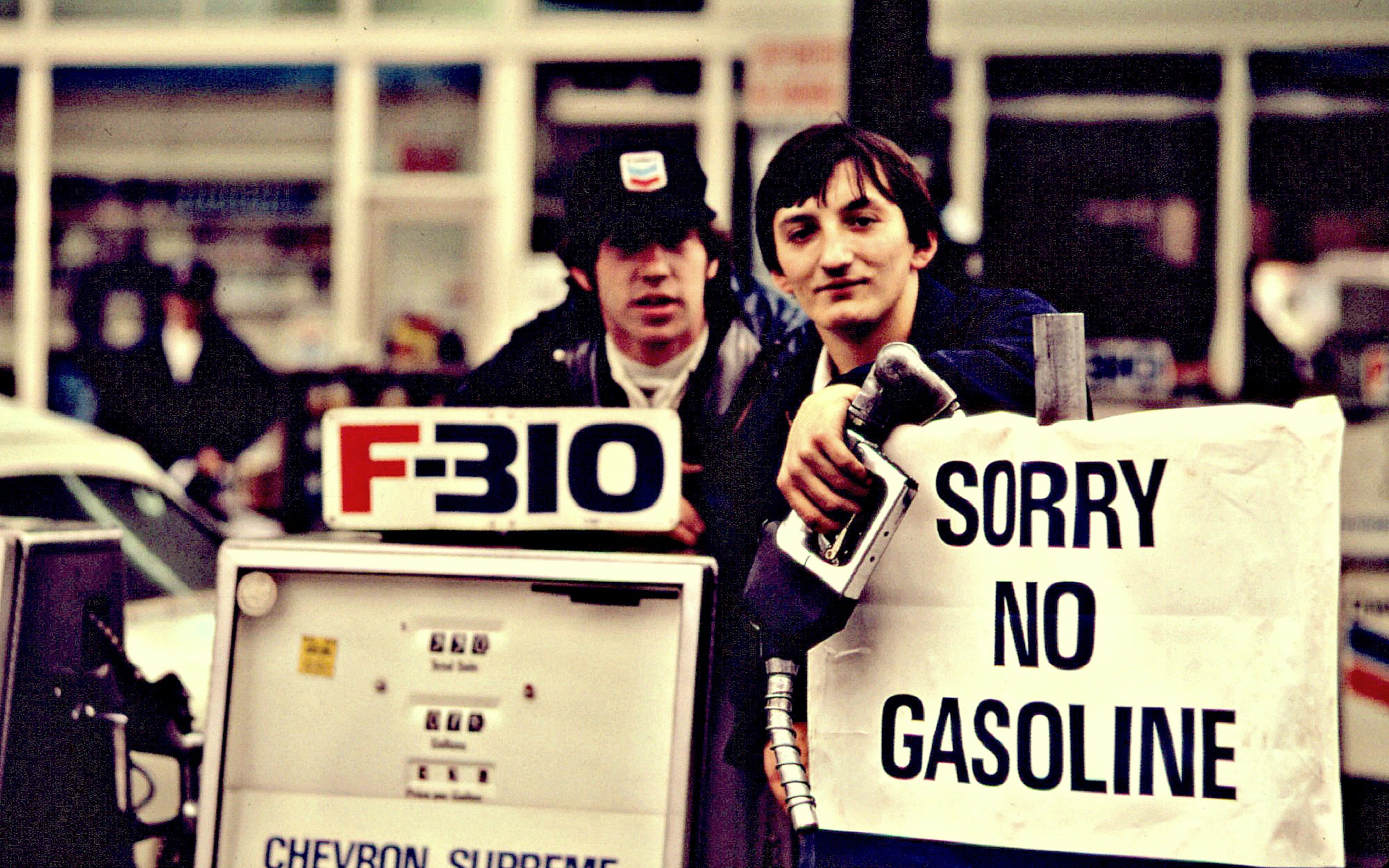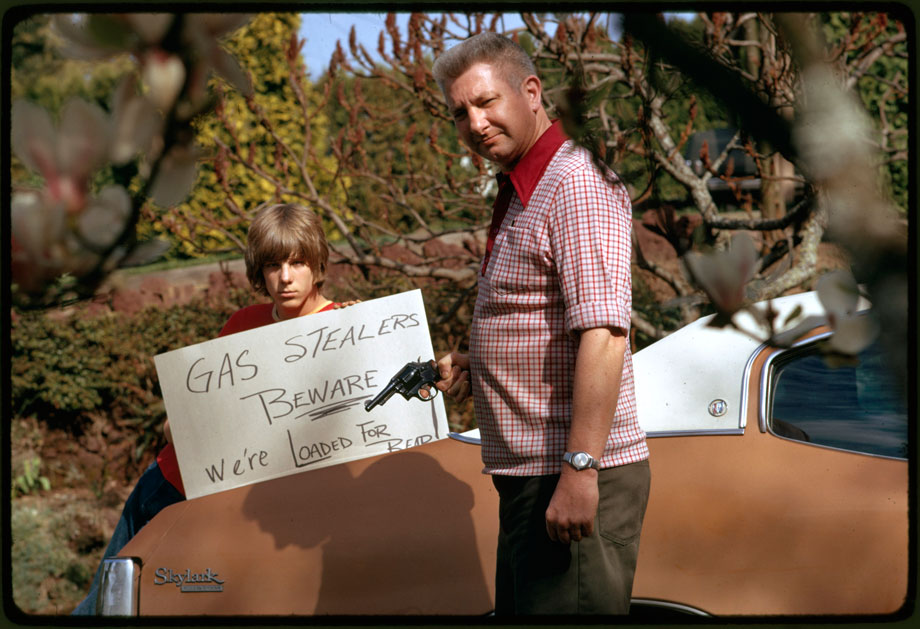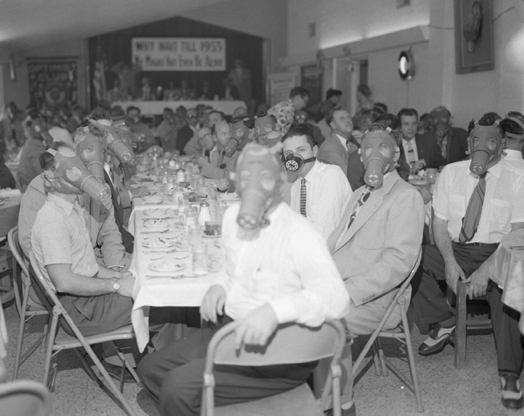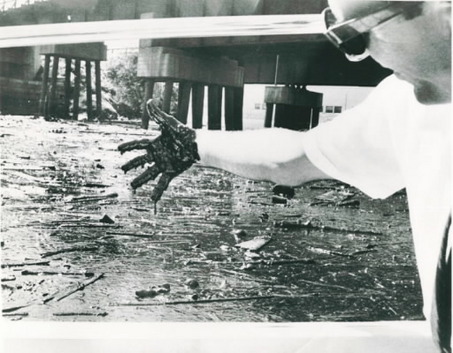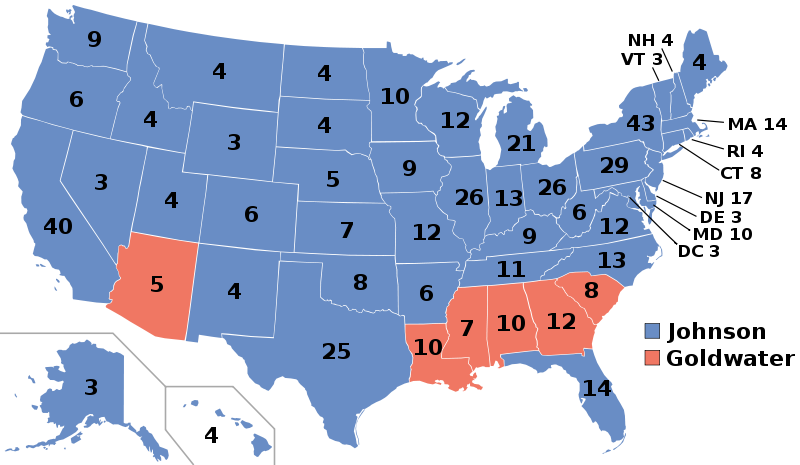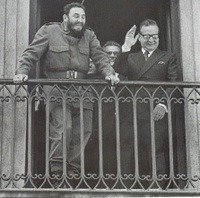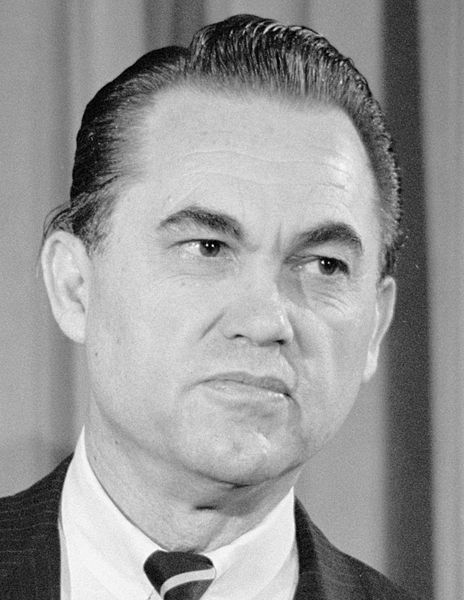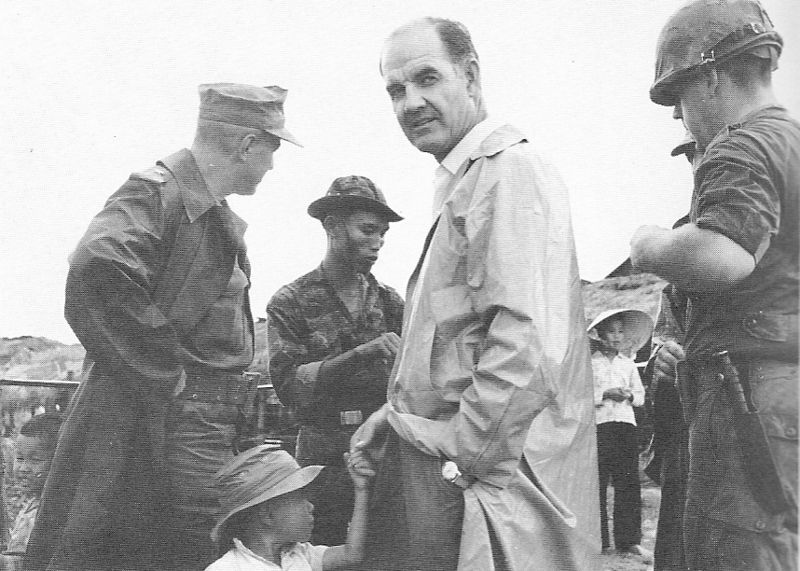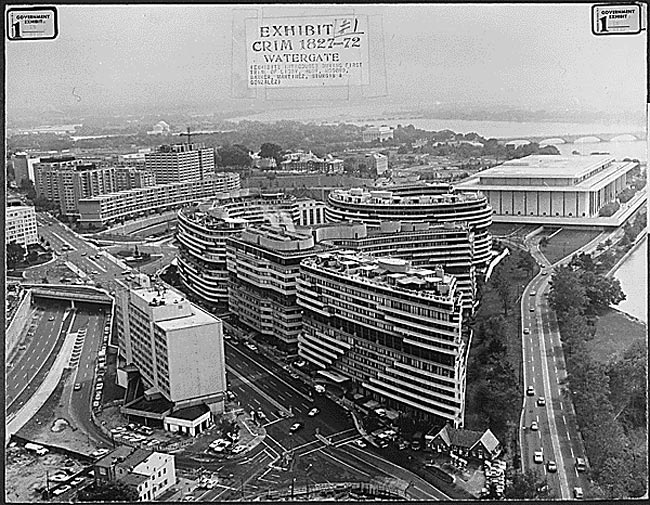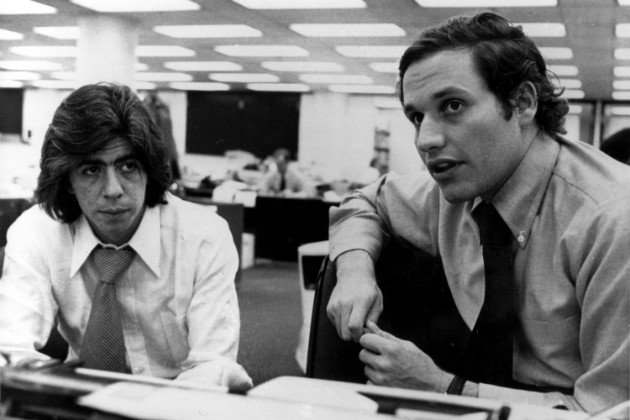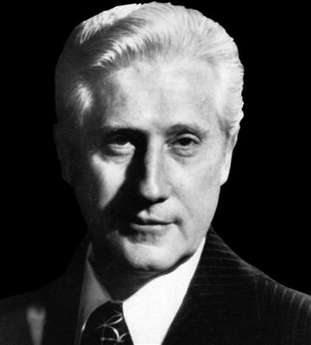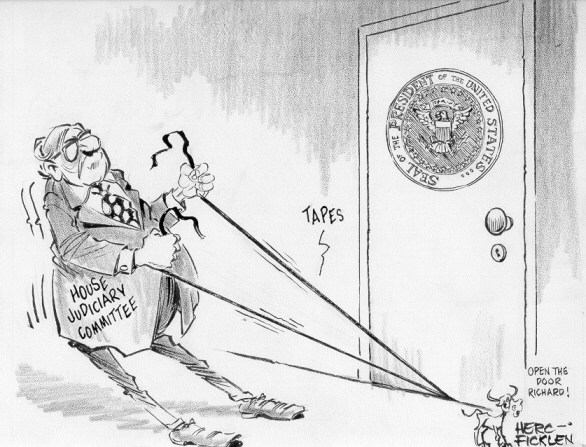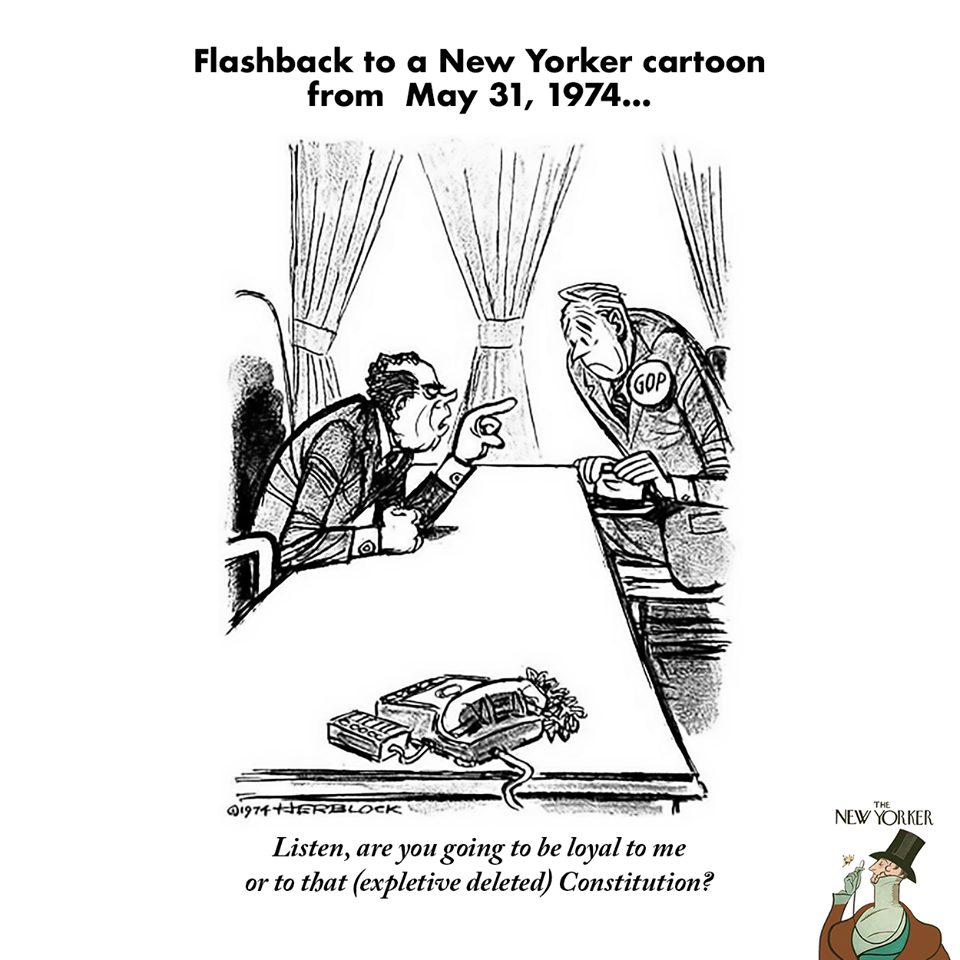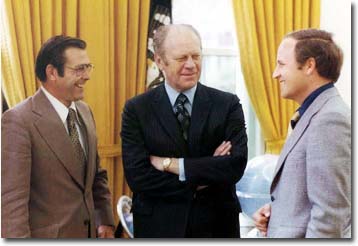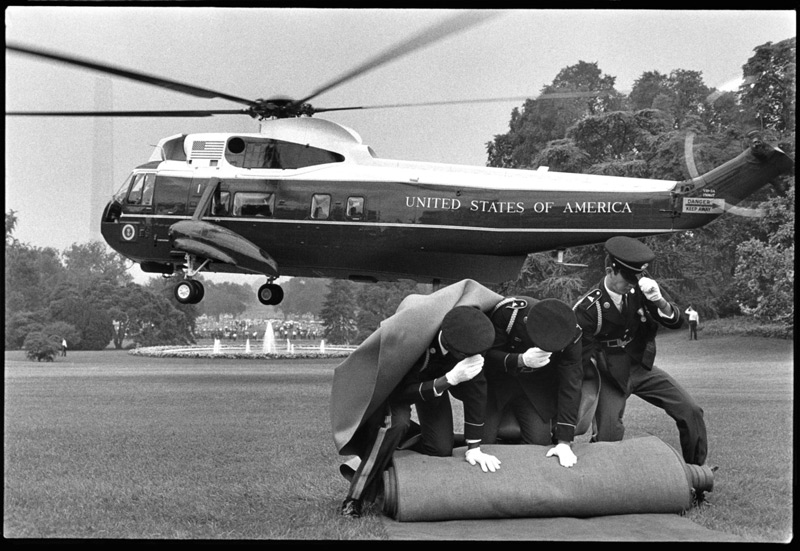“The President of the United States has the unrestrained power of granting pardon for treason; which may be sometimes exercised to screen from punishment those whom he had secretly instigated to commit the crime, and thereby prevent a discovery of his own guilt.”
— George Mason, Objections to the Constitution, 9.13.1787
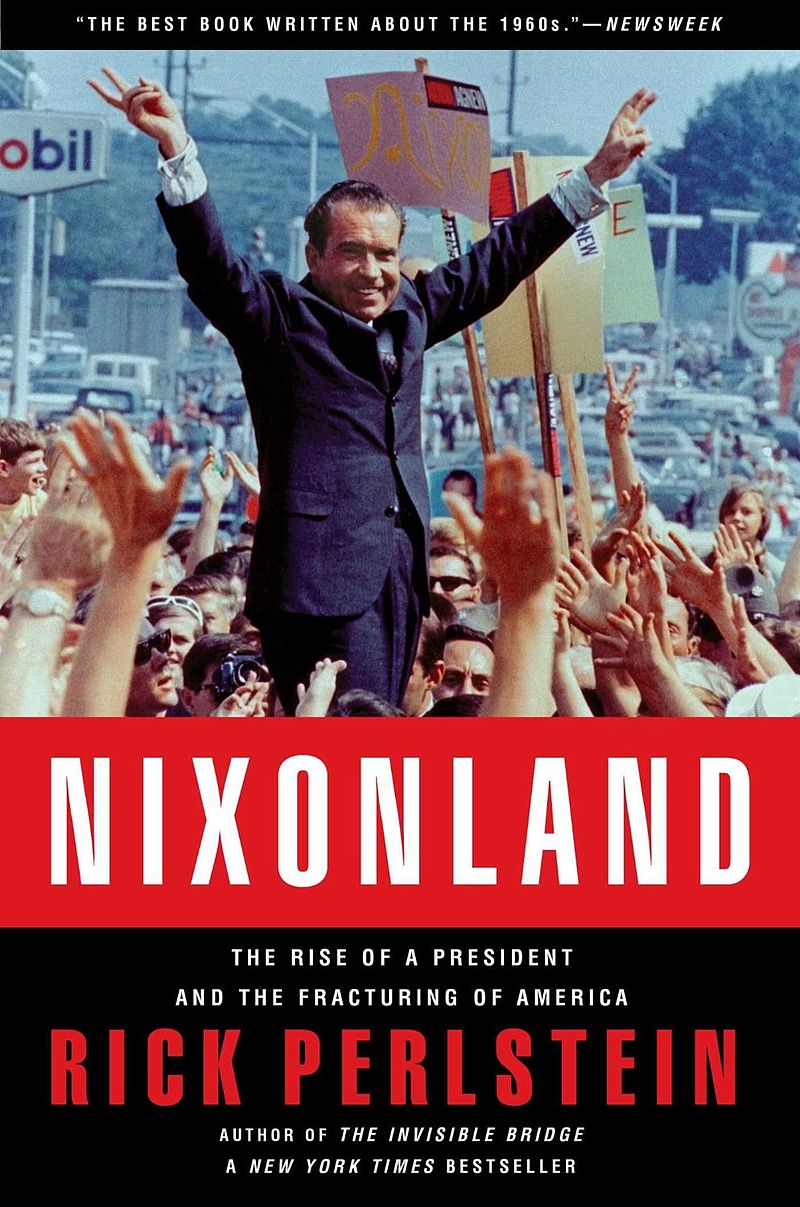 Democrats struggled to present a coherent platform after their disorganized 1968 Chicago Convention. Their candidate, Hubert Humphrey, pledged to stay the course in Vietnam and lost to Republican Richard Nixon, who rebounded from his loss to John Kennedy in 1960. Co-opting George Wallace’s appeals to white middle America, the Californian promised the “silent majority” watching the chaos of the 1960s unfold on TV that he’d clean up the country. He said, ironically in retrospect, that “no one is above the law and nobody is below the law and Americans are going to need to remember that if we’re going to have law and order.” As we saw in Chapter 16, rather than healing the divisive fractures of the 1960s, Nixon cleverly manipulated divisiveness to his advantage, further refining the age-old “politics of grievance.” In the words of historian/journalist Rick Perlstein, Nixon “co-opted the liberals’ populism, channeling it into rage at the sophisticates, the well-born, the best circles.’”
Democrats struggled to present a coherent platform after their disorganized 1968 Chicago Convention. Their candidate, Hubert Humphrey, pledged to stay the course in Vietnam and lost to Republican Richard Nixon, who rebounded from his loss to John Kennedy in 1960. Co-opting George Wallace’s appeals to white middle America, the Californian promised the “silent majority” watching the chaos of the 1960s unfold on TV that he’d clean up the country. He said, ironically in retrospect, that “no one is above the law and nobody is below the law and Americans are going to need to remember that if we’re going to have law and order.” As we saw in Chapter 16, rather than healing the divisive fractures of the 1960s, Nixon cleverly manipulated divisiveness to his advantage, further refining the age-old “politics of grievance.” In the words of historian/journalist Rick Perlstein, Nixon “co-opted the liberals’ populism, channeling it into rage at the sophisticates, the well-born, the best circles.’”
Little did Nixon or they know when he promised “law and order” that nearly his entire administration would end up in prison, including his VP, Spiro Agnew, who railed against liberal permissiveness before going to prison on 40 felony charges. But Nixon only brought Agnew on board to smear the left, just as Eisenhower brought on Nixon in the 1950s as his resident anti-communist. Nixon’s real VP was Henry Kissinger, his National Security Adviser and eventual Secretary of State, who had retired as diplomacy professor at Harvard. Kissinger, whose Jewish family escaped Nazi Germany in the 1930s, was well known as an adviser to John Kennedy and Lyndon Johnson who specialized in seeing the realpolitik big picture of international relations in terms of the balance of power. While his foreign policy was callous around the edges and failed to bring about victory in Vietnam, Kissinger helped defuse the edge-of-Armageddon tensions that characterized Cold War relations in the 1950s and early ’60s.
Détente
Nixon and Kissinger realized that, while China and the USSR were both communist countries, they weren’t allies. Josef Stalin had re-embraced family values in the USSR whereas traditional Marxist-Leninist and Chinese communism saw nuclear families as, like the religious opiate, yet another distraction from worker exploitation. Sharing a border for three thousand years also engendered hostility between China and Russia/USSR. By 1971, an ongoing border dispute made Sino-Soviet relations worse than they’d been since China went communist in 1949. Nixon and Kissinger pitted China and the USSR against each other for America’s affection. Put another way, they triangulated the relationship by cozying up to each in the hopes of warming relations with the other. As part of their détente strategy (French for relaxation of tensions), the U.S. exported corn and wheat to the Soviets and talked arms reduction. And, while Kissinger initially thought there was only a “fat chance” of improving Sino-American relations, Nixon wanted to visit China and do just that. They opened up American relations with the Chinese for the first time since the 1949 revolution and gave the Chinese satellite photos showing Soviet armaments along the Sino-Soviet border.
This was a long way from Nixon’s hard-line stance as VP under Eisenhower in the 1950s when he complained about Ike’s “togetherness bulls**t.” Since he’d been such a notorious anti-communist since the late 1940s, attacking domestic foes for being weak against the Soviets and Chinese, the phrase Nixon-to-China entered the lexicon to describe hardliners making a deal with their adversaries. It was analogous to conservative Democrat Lyndon Johnson blocking civil rights legislation then taking the lead on passing it a few years later as president. Some remarked that “only Nixon could go to China,” meaning that if anyone else had, they would’ve been criticized mercilessly by none other than Nixon. Really, Nixon was no more into togetherness in the early ’70s than he had been twenty years earlier, but he hoped that building relationships with the USSR and China would ensure that both honored America’s ongoing role in global affairs.
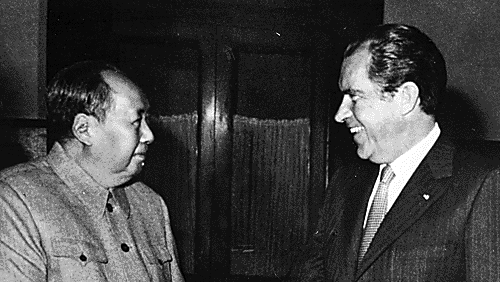
President Nixon & China’s Communist Party Leader Mao Tse-Tung, 1972, Nixon Presidential Materials, National Archives
The U.S. even greased the skids by sending a ping-pong team to China first, before they arrived on diplomatic missions. Then, to avoid public scrutiny, they established Chinese relations through the “back-channel” of their embassy in West Pakistan (now Pakistan) rather than directly. The U.S. shared intelligence on Soviet maneuvers with China and we now know that Kissinger even suggested to chief diplomat Zhou Enlai that the U.S. would eventually withdraw from South Korea and help China check Japan’s potential military re-emergence, neither of which happened.
The U.S. also pledged through its revised One China Policy to turn the tables and recognize China instead of Taiwan diplomatically — the opposite of U.S. policy from 1949-71 — even though the U.S. continued to sell arms to Taiwan to defend it from potential Chinese aggression and promise protection via the 1979 Taiwan Relations Act which, to this day, sustains tedious and delicate high-wire diplomacy between the U.S., Taiwan, and China. In 1971, Nixon and Kissinger agreed to later pull U.S. troops out of Taiwan, which happened in 1979. The situation is confusing, to say the least, as President-elect Donald Trump discovered in 2016 when he ruffled China’s feathers by accepting a congratulatory call from Taiwanese president Tsai Ing-wen. Joe Biden did likewise in 2021 by too openly expressing America’s military commitment to back Taiwan in the event of a Chinese invasion, which the White House spokespeople carefully walked back the next day toward the longstanding official policy of strategic ambiguity. Translation: the U.S. bilateral agreement with Taiwan remains understood but unspoken, and the U.S. may or may not come to their defense militarily. Dozens of western companies (e.g., Dior, Calvin Klein, Audi) have had to apologize to China for referring to Taiwan as a country. Wrestler/Actor John Cena delivered his apology in Mandarin to stay in good graces with the larger Chinese market. The root of the problem is that, while both agreed in 1992 that there is only one true China, they disagree on which one it is. The U.S. can’t recognize two countries that claim the same territory because to do so would violate the main purpose of diplomatic recognition. Likewise, the United Nations replaced Taiwan’s spot with China’s in 1971. It’s an odd situation but one that so far has prevented war insofar as Taiwan thinks that if it declared independence then China would try to conquer it to snuff out a rebellion in what it considers its own country. Conversely, if they just stand pat and don’t shoot off their mouth by declaring independence, then hopefully China won’t act and they can continue operating as a de facto country. Taiwan has already been independent in reality anyway since its leaders lost the civil war on the mainland in 1949 and retreated to the island shown in red below. Taiwan is a thriving capitalist democracy that may or may not have a de facto bilateral security pact with the United States. The two states maintain offices in each others’ countries that aren’t officially known as embassies and the U.S. continues to sell weapons to Taiwan. When U.S. congresswoman Nancy Pelosi (D-CA) visited Taiwan in 2022, China ran military maneuvers offshore to protest. With the 2022 Taiwan Policy Act, the U.S. implied that it would treat Taiwan as if it was in NATO even though it’s in Asia, pledging to defend it and impose severe sanctions on China for hostile actions toward Taiwan.
Nixon and Kissinger’s détente strategy worked insofar as it thawed Cold War tensions and improved relations between the U.S. and its two biggest rivals, the USSR and China. The peaceful framework in China set the stage for the country’s economic growth under Deng Xiaoping in the 1980s, helping to pull millions of Asians out of poverty. Moreover, détente jumpstarted the Strategic Arms Limitation Talks (SALT I) between the Americans and Soviets and led to the cooperation between the two powers’ space programs that Kennedy had envisioned.
But détente failed to accomplish its secondary goal. Based on what they called linkage, Nixon and Kissinger hoped détente would end the Vietnam War because the Chinese and Soviets would order the North Vietnamese out of the South to avoid botching their improved American relations. It turns out that the North Vietnamese were happy to take weapons and supplies from the Chinese and Soviets, but not orders. Likewise, they hadn’t followed the big communist powers’ advice to stay out of South Vietnam in the first place in the 1950s. They weren’t retreating out of the South regardless of what happened in the larger context of the Cold War. For that matter, neither were the Soviets or Chinese trying to bail the U.S. out of its Vietnam predicament anyway; they were happy to let the U.S. twist in the wind. In fact, they both increased their North Vietnamese support in the early 1970s. Ultimately, Nixon was forced to accept a truce in Vietnam under the realization that America’s South Vietnamese allies wouldn’t be able to fend off the North Vietnamese communists. Nixon and Kissinger later regretted pulling U.S. troops out of Taiwan to signal their willingness to negotiate instead of hanging on to that bargaining chip to compel China to curtail North Vietnam. Kissinger wrote that “in foreign relations, countries are never paid for services already rendered.”
Yet, the brief improvement in overall relations with communist powers arguably set the U.S. up for its ultimate victory in the Cold War over the Soviets. The French have a saying, reculer pour mieux sauter, that translates roughly into, “take a few steps back to gather speed so you can jump further forward.” A positive spin on détente credits this brief retreat from the more militant Cold War of the 1950s and early 60’s as a necessary breather before the “jump forward” (stepped up tensions) of the 1980s. Having over-extended in Vietnam, Nixon and Kissinger realized that the U.S. didn’t have the leverage for a more confrontational stance with the Soviets and Chinese in the early 1970s, just as the Soviets didn’t after their disastrous foray into Afghanistan in the 1980s. It’s fortunate that the Nixon administration didn’t go so far as to surrender South Korea or abandon Japan on behalf of this reboot with China.
Middle East & Israel
In the Middle East, Nixon and Kissinger modified America’s unconditional support for Israel, also as part of their linkage plan to relax world tensions. Since its creation in 1947-48, the U.S. viewed Israel as an important democratic ally in the Middle East and source of intelligence regarding its neighbors. American military contractors profited from building Israel weapons and, similar to England’s strategic role in World War II, former Secretary of State Alexander Haig described Israel as our “unsinkable aircraft carrier” in the Middle East. Starting with Nixon and Kissinger, the U.S. still sent a considerable amount of aid and discounted weapons to Israel, including a missile defense system — more aid than went to all of Africa and Latin America combined — but also tried to broker peace in the region. In 2021, the U.S. sent ~ 10% of its foreign aid to Israel: $3.8/38+ billion. (NOTE: a 2010 poll showed that, on average, Americans think around 25% of the federal budget goes to foreign aid and would prefer that it be less at 10%. The real amount is less than 1%.)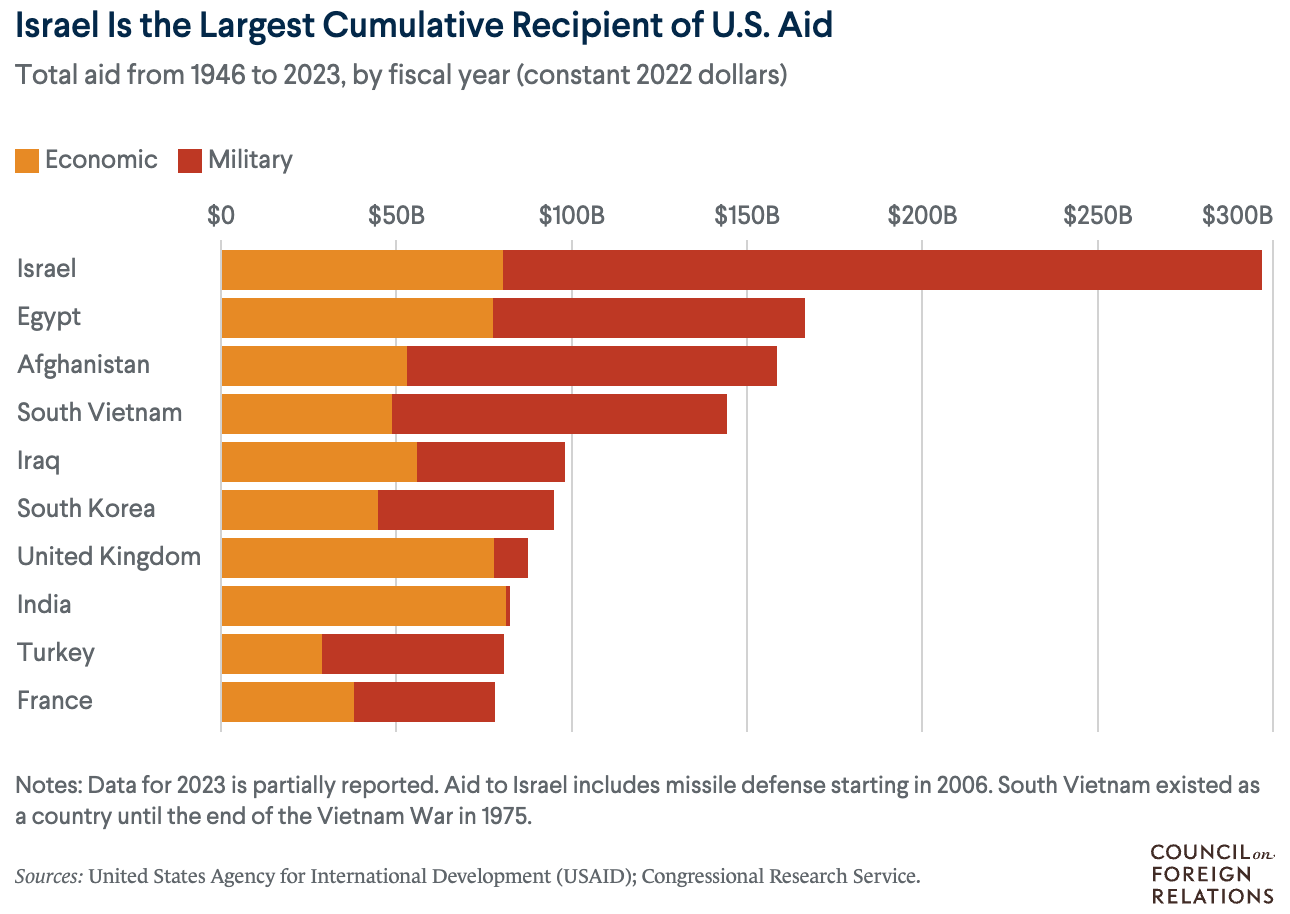
Some historical background is helpful in explaining America’s complicated and controversial relationship with Israel (in red oval below). Britain controlled Palestine (present-day Israel) after WWI, taking the territory from the Ottoman Empire at the very end of its 623-year reign from 1299 to 1922. During World War I’s Arab Revolt, Britain promised Arabs in area independence in order to rally their support against the Ottomans, who were allied with Germany, while simultaneously promising to secure a new Jewish homeland in the Balfour Declaration. After WWII, though, British administers struggled to balance their obligations to both camps in their League of Nations Mandate territory. Their Royal Navy even seized a packet steamer full of Holocaust refugees relocating to Palestine and sent them back to Europe. The deportation of the Exodus 1947 passengers helped fuel the cause of Zionism: the idea that a new state should be created in the region that Jews inhabited during Biblical times. Zionism gained momentum late in the 19th century behind writers like Austrian Theodore Herzl as European Jews realized that their Haskalah dream of cultural assimilation was failing. They experienced increasing discrimination across Europe in the 19th and early 20th centuries, culminating in the Holocaust, or Shoah, of WWII. As we saw in Chapter 13, with its racist 1920s immigration policies still in place, the U.S. offered asylum to only a small percentage of Holocaust survivors. A combination of post-Holocaust sympathy and ongoing anti-Semitism, expressed in anti-immigration policies, buttressed Zionist support among Gentiles after World War II for a Jewish country.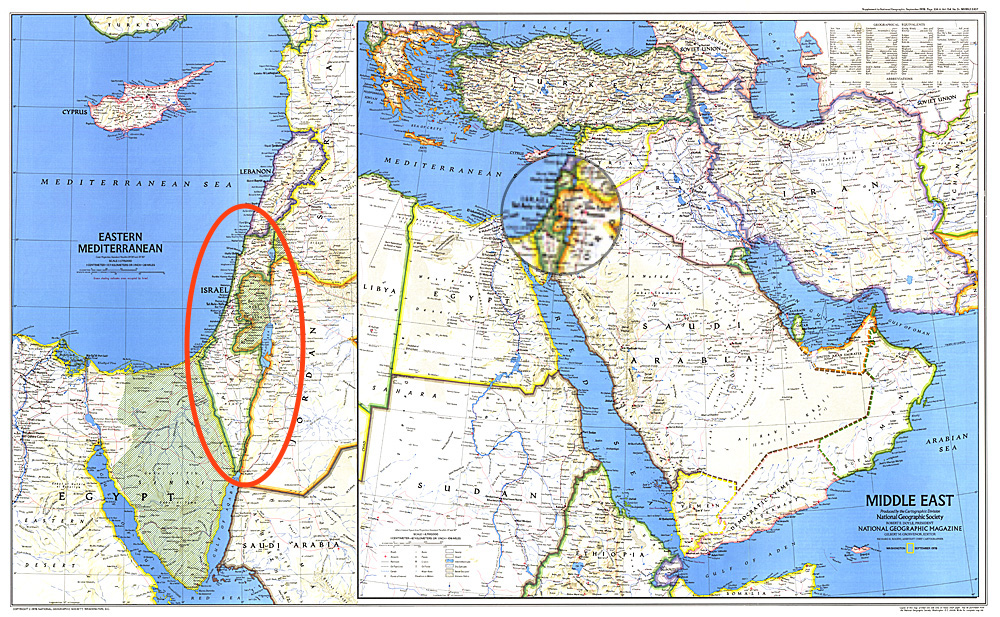
In 1947, the United Nations sanctioned Israel’s creation out of Palestine, a portion of the eastern Mediterranean Levant inhabited by Jews, Muslims, and Christians (~ 6%), supporting equality for all inhabitants. Note: many sources use the term Palestinian to mean Arab Israelis but not Jewish Israelis, and the geographic terms Israel and Palestine don’t overlap exactly. If you see the term Palestinian in the news, it likely means Arab, of whom around 80% are Sunni Muslim (the other 20% of Arab Palestinians are Christian or Druze). Partly on the advice of Jewish Supreme Court Justice Louis Brandeis and adviser Clark Clifford, both of whom saw supporting Israel as a moral imperative, Harry Truman broke from his predecessor FDR and the U.S. recognized the new country in 1948, despite reservations from Secretary of State George Marshall that it would alienate Arab oil exporters. Simultaneously, Truman assured Saudi Arabia of America’s commitment to its territorial integrity, writing Ibn Saud that any threat to the country would be “of immediate concern to the U.S.” The United Nations set aside some land for Arab Palestinians in the United Nations Partition Plan, but Arab countries didn’t recognize the agreement. Israel’s creation was sanctioned by a combination of the League of Nations and United Nations, though the UN today mainly advocates on behalf of Arabs within Israel.
In the 1948 War, Israel took more land, expanding their original territory from 56% to 80% of British Palestine, and much of the remaining Palestinian territory was scattered rather than contiguous. Around 75% of Arabs were displaced during this original Nakba. Arab areas lacked utilities and sewage and had to go through Israeli checkpoints to move between their zones. In response, Arabs kicked Jews out of other countries across the Middle East and North Africa but most migrated to Israel, doubling its population. Taking advantage of the Law of Return (1950- ), other immigrants from the Jewish Diaspora moved to Israel from India, East Africa, America, the Caucasus, and Russia. However, Arab Palestinians displaced by Israel’s creation lack the right of return and neighboring Arab states also refused them citizenship because they thought that sanctioned Israel’s aggression.
 Jewish Fundamentalists claimed scriptural justifications for taking the land and many Christian Fundamentalists support Zionism as a prerequisite for the Second Coming of Christ (Christian Zionism). Zionists made an irrendentist argument that Jews had historical claims on the territory dating back to antiquity and Arab Palestinians weren’t farming the land anyway. Jews were “people without a land, returning to a land without a people” in this line of thought. The former at least was true, if not the latter. Zionists stressed the sparseness of the Arab population – similar to arguments used against indigenous Americans (North and South), South Africans, and Australians, except that Jews predated Arabs in Palestine so are, themselves, indigenous. The Zionists’ strongest argument was that they had nowhere else to live. Germans massacred most European Jews in the Holocaust, while Britain, Australia, and America mostly closed their borders to refugees. They even mostly closed their borders to survivors after the war. The Holocaust, combined with the inaction of other countries, made Jewish survival dependent on creating their own country. As for historical claims, many people have lived in many places over the centuries. But, in Israel’s case, those claims have special resonance among allies like the U.S. because its dominant faith of Christianity also traces to the [Jewish] Old Testament. Moreover, Israel is a democratic country in a mostly autocratic region.
Jewish Fundamentalists claimed scriptural justifications for taking the land and many Christian Fundamentalists support Zionism as a prerequisite for the Second Coming of Christ (Christian Zionism). Zionists made an irrendentist argument that Jews had historical claims on the territory dating back to antiquity and Arab Palestinians weren’t farming the land anyway. Jews were “people without a land, returning to a land without a people” in this line of thought. The former at least was true, if not the latter. Zionists stressed the sparseness of the Arab population – similar to arguments used against indigenous Americans (North and South), South Africans, and Australians, except that Jews predated Arabs in Palestine so are, themselves, indigenous. The Zionists’ strongest argument was that they had nowhere else to live. Germans massacred most European Jews in the Holocaust, while Britain, Australia, and America mostly closed their borders to refugees. They even mostly closed their borders to survivors after the war. The Holocaust, combined with the inaction of other countries, made Jewish survival dependent on creating their own country. As for historical claims, many people have lived in many places over the centuries. But, in Israel’s case, those claims have special resonance among allies like the U.S. because its dominant faith of Christianity also traces to the [Jewish] Old Testament. Moreover, Israel is a democratic country in a mostly autocratic region.
Palestinian and other Arab Muslims resented Israel’s creation. There was another war in 1956 and tensions were simmering to a boil by the mid-1960s. The U.S. increased its support for Israel in the 1960s as Lyndon Johnson coveted Israeli intelligence on Soviet aid to surrounding Arab countries. Arab League countries, including Egypt, Jordan, and Syria, prepared to attack Israel in 1967 and Israel preemptively struck first with American weapons, pushing back borders and making their country even bigger during the Six-Day War. They seized what came to be known as the Occupied Territories: the Sinai Peninsula and Gaza Strip (from Egypt), Golan Heights (from Syria), and, from Jordan, the West Bank of the Dead Sea and Jordan River and East Jerusalem, the city claimed by all three of the Abrahamic religions. According to retired Brigadier General Itzhak Yaakov, Israel was prepared to detonate a nuclear weapon atop Mt. Sinai as a demonstration to its invaders had they threatened to overrun them.
Mt. Sinai, on the Sinai peninsula, is where Moses of the Old Testament purportedly received the Ten Commandments. Jerusalem was the heart of Judea after the Jewish Exodus from Egypt and the epicenter of Jesus’ ministry and site of his crucifixion (his birthplace Bethlehem is in the Israeli-occupied West Bank). In the 8th century CE, Muslims built their Dome of the Rock atop the sacred Jewish Temple Mount, the purported site where God created Adam and Eve and Isaac bound his son, and of the old Jewish temples. Jerusalem is also the site of Muhammed’s western-most journey and purported ascent into heaven.

Southern Aerial View of the Temple Mount & Al-Aqsa Mosque in the Old City of Jerusalem. On the Lower Left is the Western Wall, or Wailing Wall, Remnant of the 2nd Jewish Temple
Today, the Jewish Settler Movement to develop the Occupied Territories is controversial within Israel and abroad, especially since United Nations Resolutions 242 called for withdrawing. Many “Zionists of Necessity” believe that, while Israel is necessary as a long-term Jewish safe haven, it should be less aggressive and revert to a more defensible territory. Many secular Jews don’t sympathize with the fundamentalist scriptural claims to expanding Israeli territory. The map below shows the Arab League countries in green, surrounding Israel in gray. Geography sheds light on the controversy, suggesting that Arab complaints against Israel concern race and religion rather than an actual shortage of territory, along with the principle of their displacement in 1948 and ’67. Arab Israelis outside of the occupied Palestinian territory attained citizenship and suffrage within Israel in 1966.
In the 1973 October War, or Yom Kippur War, Israel once again caught wind of an impending invasion but, this time, Prime Minister Golda Meir let the enemy shoot first, fearing that a preemptive strike might compromise American support. Egypt invaded the Sinai Peninsula on the holiest Jewish holiday, the Day of Atonement, attempting to reclaim the region. The U.S. initially rearmed Israel’s beleaguered military but ultimately reined in its ally, not wanting the situation to escalate into WWIII or to disrupt oil flow from Arab countries that opposed Israel. At the same time, the U.S. warned the Soviets — allies with Syria and Egypt — to stay away, just as Eisenhower had done during the Suez Crisis in 1956. Nixon and Kissinger saw the Middle East as linked to the broader Cold War, as had their predecessors, but they also presided over a country that no longer could supply all of its own oil. Consequently, they strove to balance the traditional Israeli alliance with improved Arab relations. The U.S. had secured oil concessions in Iraq, Turkey, Bahrain, Kuwait, and Saudi Arabia by mid-century, but they were cutting production to drive up prices in retaliation for Israel’s expansion. Kissinger flew back and forth between Israel and surrounding countries to arrange a truce, winning the Nobel Prize for his “shuttle diplomacy.” The U.S. reestablished relations with Egypt and Syria for the first time since the 1967 War, and maintained alliances with Saudi Arabia and Iran to keep the oil flowing and deter the Soviets from expanding into the Persian Gulf. Israel returned the Sinai Peninsula to Egypt in the Camp David Accords led by Jimmy Carter in 1978.
 By the early 21st century, the Jewish-Palestinian conflict in Israel continued to exacerbate Muslim relations with the West, creating a conundrum for the United States. Foreign correspondent Robert Kaplan wrote “Our allegiance to Israel is a matter not only of its being a democracy but also of its being a valuable chess piece — a pro-American military dynamo in the heart of the Middle East…And yet, at the same time, we must continue to try to coerce Israel on its West Bank settlements in order to relieve some of the pressure on the United States in the Muslim world…[because] the Palestinian cause has acquired a totemic significance for Muslims from North Africa to Indonesia.” Some militant Arabs would like to see another Holocaust — though they deny that the first ever happened — creating a challenging case of curbing nuclear proliferation and blunting terrorism. Israel has bombed emerging plutonium reactors in Iraq in 1981 and Syria in 2007, but not Iran’s nuclear facility at Arak, outside Tehran.
By the early 21st century, the Jewish-Palestinian conflict in Israel continued to exacerbate Muslim relations with the West, creating a conundrum for the United States. Foreign correspondent Robert Kaplan wrote “Our allegiance to Israel is a matter not only of its being a democracy but also of its being a valuable chess piece — a pro-American military dynamo in the heart of the Middle East…And yet, at the same time, we must continue to try to coerce Israel on its West Bank settlements in order to relieve some of the pressure on the United States in the Muslim world…[because] the Palestinian cause has acquired a totemic significance for Muslims from North Africa to Indonesia.” Some militant Arabs would like to see another Holocaust — though they deny that the first ever happened — creating a challenging case of curbing nuclear proliferation and blunting terrorism. Israel has bombed emerging plutonium reactors in Iraq in 1981 and Syria in 2007, but not Iran’s nuclear facility at Arak, outside Tehran.
While the ideal outcome would be an integrated, functional one-state solution, realistic segregationists push for a two-state solution of side-by-side sovereign Arab and Israeli states, similar to the original setup in 1947. But a major bone of contention is whether or not Israel would withdraw from the post-1967 Occupied Territories as part of the agreement. After the 1993-95 Oslo Accords, Arabs enjoyed some autonomy, especially over municipal matters, within the Occupied Territories as part of the Palestinian National Authority, but their West Bank zones remained noncontiguous (red, upper right). Israel’s military withdrew from Gaza in 2005. We’ll pick this story up again in Chapters 19 and 22.
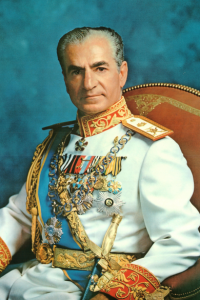 OPEC Oil Embargo > U.S. Energy Policy, 1973-
OPEC Oil Embargo > U.S. Energy Policy, 1973-
Arab countries vowed to make the West pay for Israeli occupation of the post-1967 territories. After their forementioned production cut, their punishment escalated to an OPEC-organized oil embargo followed by a price hike announced in Tehran by the Iranian Shah (Mohammed Reza Shah Pahlavi), from $3 to $12/barrel. He announced that the embargo and price hike weren’t just about Israel, but also a response to decades of Western wealth generated by exploiting cheap Middle Eastern oil. He might’ve mentioned that he personally grafted 15% of all Iranian oil profits and that, as you might remember from Chapter 14, those same Western oil powers helped put the Shah (right) in power in 1953. Nixon and subsequent presidents like Jimmy Carter would have to look the other way at the Shah’s corruption and torture in exchange for him lowering oil prices.
Formed in 1960, OPEC is an oil cartel consisting of Middle Eastern, African, and South American countries that agree to limit production and set price basements under which no member can sell (or is supposed to). Just as the Federal Reserve doesn’t set interest rates but can affect them by influencing supply-and-demand, so too, OPEC has enough members to impact crude oil prices by collectively increasing or decreasing production. Collectively, its countries supply ~ 40% of world supply. Geographer Matthew Huber chronicled how OPEC studied the way the Texas Railroad Commission effectively managed production and scarcity to maximize profits for oil producers in the 1950s and ’60s. Egypt and Syria aren’t OPEC members, but they joined the embargo. As we’ll see in the next chapter, the 1973 Oil Embargo sunk the American economy into its worst downturn since the Great Depression as the country struggled to cope with stagflation, a toxic mix of unemployment and inflation caused by oil prices that were already rising even before the Yom Kippur War.
America has had several recessions since tied to oil prices, that are in turn often tied to Middle Eastern instability and, more recently, Russia. Oil isn’t just fuel for cars, trucks, tractors, planes, and furnaces; petroleum and derivative petrochemicals are used in plastic/packaging, asphalt, tires, lubricants, polyester clothing, cosmetics (e.g., lipstick), wax, toys, etc. Most important are oil’s roles in factories and food production, including farming, processing, and shipping. OPEC tried an embargo after the 1967 War but it didn’t work because U.S. domestic consumption hadn’t yet surpassed production. It had by 1973, though, and prices quadrupled by the end of the decade. By then, America was passing into Peak Oil, variously defined as either declining production or domestic production not keeping pace with consumption. American oil wells were maxing out production by 1970 while Eisenhower-era quotas still limited imports to avoid addiction to foreign oil. The embargo’s results were higher prices due to changes in supply and demand, rations, long gas lines, and even fistfights at the pumps. The National Guard escorted fuel tankers across the country to prevent them from being hijacked. Moreover, 1972-73 was a cold winter and people that relied on oil heaters often couldn’t find enough. Some schools and colleges even shut down on cold days and airports struggled to find enough fuel for planes, grounding flights. Nixon abandoned Eisenhower’s limits on oil imports, freeing up supply but spiking world oil prices and ushering in an age of increased military ventures in the Middle East, none of which supposedly concerned oil.
By the summer of 1973, in the lead-up to the Yom Kippur War in Israel and OPEC embargo, the U.S. was importing 6.2 million barrels a day. OPEC displaced the (misnamed) Texas Railroad Commission as controller of world oil prices, but that didn’t mean that a fully functional OPEC affected all Americans negatively. Oil producers, like those who sell any commodity, want prices high. When OPEC lost control of its members and oil prices dropped in the 1980s, Vice-President George H.W. Bush traveled to Saudi Arabia to ask them to curtail production so as to raise prices. In 2022, Joe Biden lobbied unsuccessfully for them to do the opposite and raise production, to lower prices after the embargoing of Russian oil to protest their invasion of Ukraine spiked crude oil’s global spot price (western oil companies weren’t maximizing production then either, partly but not exclusively for the same reason). Energy producers that make up ~ 6% of today’s S&P 500 like oil prices high while everyone else wants them low. Texas experienced an economic downturn in the 1980s when prices dropped.
From 1973 on, the U.S. has continued to support Israel, but more as an intermediary trying to negotiate peace between Israel and its surrounding neighbors. It has also tried unsuccessfully to broker a lasting peace between Palestinian Arabs and Jews. Simultaneously, America also stayed committed to protecting the flow of Middle Eastern oil to itself, Japan, and Europe as its big oil conglomerates began to cede direct control of the precious commodity to nationalized Arab companies. Saudi Aramco, for instance, assumed full control of Saudi oil by 1980 whereas, under the old arrangement, “Baby Standards” Chevron, Exxon, Mobil, and Texaco ran the consortium. The U.S. now gets less than a third of its black gold from the region but Europe and Japan are more dependent, and America re-wrote the German and Japanese constitutions after WWII to keep their militaries as defensive, skeletal forces. Only since 2022, after Russia’s Ukrainian invasion, has Germany started to seriously build up its military, though it’s been a solid contributor to NATO in the interim. In the thirty years between 1976-2007, even ignoring the costs and casualties of big-ticket conflicts in Iraq (2x) and Afghanistan, the U.S. spent over $7 trillion maintaining troops and bases in the Middle East.
Today, Americans have to weigh that enormous cost against the environmental hazards and intensive water use of hydraulic fracturing, or the fracking of “tight oil” and shale (natural) gas, which has the potential to make “Saudi America” energy-independent by the 2030s and has already enabled the U.S. to surpass Saudi Arabia and Russia in overall energy production. In 2023, for instance, the U.S. pumped more oil than any country in history. Hydraulic fracturing was developed in Kansas in the 1940s but didn’t come of age until combined with horizontal drilling in the early 21st century. By 2014, it had led to a considerable drop in oil and gas prices, helping American consumers and weakening “petro-dictatorships” like that of Russia’s Vladimir Putin and Venezuela’s Hugo Chávez. But during COVID-19, disruptions in the oil supply chain contributed to inflation. At first, demand dropped during initial lockdowns, leading to sharp decreases in production. Inventory was so overwhelming that, astoundingly, prices at one point dropped to $ -37/barrel as tanks in storage hubs like Cushing, Oklahoma filled up. Then, when economies started opening, supply couldn’t meet demand as production was slow to ramp back up, especially with fewer workers and truck drivers. OPEC kept their production low to take advantage of high prices. When Russia invaded Ukraine in 2022, the West mostly embargoed Russian oil and gas, driving prices even higher, but American oil companies were hesitant to tap their unused leases, partly because they like prices high anyway, partly because of labor shortages, and partly because they’re hesitant to make long-term investments with more electric vehicles on the horizon. Meanwhile, unlike manufacturers of the late 19th century who were outproducing demand (Chapter 3), America continues to use more oil than it produces.
Without meaningful progress on renewable energy storage or safer ways to extract and transport petroleum, Americans will be stuck choosing between the chemicals in their water, methane emissions (better regulated post-2023), potential water shortages, small earthquakes caused by post-fracking wastewater re-injection, exploding pipelines and offshore rigs, or sending their sons and daughters to the desert to dodge IEDs. Luckily, the 1973 OPEC Embargo helped lower carbon emissions in the next forty years below what they would’ve been without it. Because of the premature application of the Peak Oil theory, many analysts at the time wrongly thought the world’s oil reserves were insufficient, jumpstarting a concern for alternative energy and greater efficiency that engineers could build on when climate change became a concern later. Some of these problems would fade away with a transition to electric vehicles but, in the short-term, much of the electricity used to power those EV’s will come from fossil fuels. Still, an internal-combustion engine running on fuel creates ~ 5x more carbon footprint than an electric car or truck charged 100% with coal, and EV’s can be charged from renewables or nuclear power.
While the environmental/conservation movement had a long history, it wasn’t really until the Nixon era that Americans began to think seriously about the constraints of energy supply. But the president himself was more known for his interest in diplomacy than domestic issues like the environment. Nixon once said he wasn’t in the White House to “fix an outhouse in Peoria,” meaning that he preferred to focus more on foreign than domestic policy. At home, liberal Democrats controlled both houses of Congress, so Lyndon Johnson’s Great Society continued through Nixon’s administration even though Nixon was a moderate Republican on the political spectrum, in the Eisenhower tradition. Likewise, the Supreme Court overseen by Republican Warren Burger (Chief Justice, 1969-86) generally leaned left on issues involving abortion, desegregation, and religious freedom. Many moderate Republicans of the era promoted civil rights and endorsed pollution control, just as some southern Democrats opposed them.
 Environmental Law
Environmental Law
Today, pollution kills ~ 100k Americans per year and the World Health Organization (WHO) estimates that outdoor, ambient air pollution kills 4.5 million per year globally (9 million total counting indoor pollutants). The American count would no doubt be far higher if not for hard-fought regulations passed during the Great Society era. In 1970, Congress strengthened the 1963 Clean Air Act, the second anti-pollution law in world history behind the British. Though they focused on different toxins, the 1963 law was spurred by publication of Rachel Carson’s Silent Spring (1962), that alerted the public to the dangers of pesticides and the chemical industry’s disinformation policy which, in turn, launched a smear campaign against her that continues today. Carson was perhaps the most influential muckraker since Upton Sinclair, whose Jungle (1906) helped reform the food industry. She traced research funding to industries that had a stake in the results of that same research, a common issue that arises in other fields. Writing as she died of breast cancer, the former marine biologist for the Fish & Wildlife Service contended that pesticides were carcinogenic and harmed fish and animals that fed on fish, including eagles, when they drained into water. Silent Spring led to a 1972 ban on DDT in the U.S., a compound used on crops for pests and in homes to reduce mosquitoes. This likely saved America’s symbol, the bald eagle, because ingesting the chemical made their eggshells too thin. Yet, the chemical mitigated typhoid epidemics in Europe during WWII by reducing lice. Since malaria-carrying mosquitoes continued to wreak havoc worldwide, right-wing critics like Breitbart grouped Carson with mass-killers Hitler, Stalin, Mao, and Pol Pot, ignoring intent if not scale, and assuming that Carson inspired a global ban.
Hyperbole aside, environmentalists partially fell into in post hoc fallacy by noting increased cancer rates in developing countries that used DDT, insofar as fewer deaths from malaria allowed people to live long enough to develop cancer (see Rear Defogger #6). But modern national and global agencies have listed DDT as a possible carcinogenic, especially in relation to breast cancer and lymphoma. In any event, the U.S. ban didn’t extend to other nations and Carson understood the need for chemicals and to control pests. She didn’t call for DDT’s elimination but rather more judicious use, so that mosquitoes wouldn’t develop resistance which, in fact, they later did in some areas.
Nixon consolidated various regulatory agencies with a hand in pollution by creating the EPA, or Environmental Protection Agency in 1970. Additionally, Congress passed the Clean Water Act in 1972, Endangered Species Act in 1973, and Safe Drinking Water Act in 1974. Nixon vetoed the Clean Air Act revisions because he feared that it would destroy the economy, but Congress overrode him. Resisting these new laws and agencies, the auto industry stalled implementation of new emission standards until the late 1970s but the EPA, based on Herbert Needleman’s case studies, removed brain-damaging lead from gasoline, though lead still exists in some old wall paint, ammunition, and pipelines. We touched on lead in Chapter 17 and will again in Chapter 20, as it likely connected to crime rates. One man, Thomas Midgley, Jr., engineered both tetraethyllead gasoline and ozone-layer-eating chlorofluorocarbons (aka Freon) in the 1920s, prompting one environmental historian to claim “he had more impact on the atmosphere than any organism in history.” After CFCs opened a hole in the ozone over Antarctica in the 1970s, countries agreed in the 1987 Montreal Protocol to start phasing them out in 1989, and the hole has since shrunk. Dealing with CFCs demonstrated that scientists can diagnose a problem correctly and nations can cooperate in solving it — which is worth knowing if our natural inclination is to think that global cooperation on carbon emissions, for instance, is hopelessly idealistic (tribalism is a strong centripetal force). Coping with the worst smog in the country, of which cars cause about half, the California Air Resources Board (CARB) led the way on air pollution, spurring gas stations to use vapor-lock nozzles and automakers to design engines and exhaust systems/catalytic converters that emitted less nitrogen oxide, sulfur oxides, carbon monoxide, and other particulates.
Prior to the 1960s, companies could spew anything they pleased into the air or dump toxic waste and sewage into any stream or lake. Cities like Pittsburgh weren’t a lot different than China today, where often people can’t go outside during thermal inversions. Several times in the 1950s and ’60s, the Cuyahoga River in Cleveland actually caught fire. It was impossible to swim in many rivers without risking bacterial or viral infections. Thick smog drives up asthma and cancer rates along with healthcare insurance, and chemicals kill fish and likely harm people that eat poisoned fish. Economic libertarians don’t believe that pollution is good, but rather that today’s companies and utilities would strike the proper balance between economic growth and safety on their own without being compelled. All we know for sure is that they made no such effort before the regulations. In many jurisdictions, corporations are obligated to act in their investors’ interests (shareholder primacy doctrine).
While difficult to imagine today, there was widespread bipartisan support for environmental measures during the Nixon era despite other controversies that split the parties. Had that not been the case, they wouldn’t have overridden Nixon’s veto of the 1970 Clean Air Act, that passed the House 374-1 and Senate 73-0. Conservatives and liberals have a complicated and overlapping history regarding environmental and conservation concerns. As we saw in Chapter 5, no early president did more to cordon off protected wilderness than Republican Teddy Roosevelt and, in the early 20th century, rural hunters established a licensing system to save white-tailed deer from near extinction. Today, some evangelicals and Front Porchers part ways with the Republican Party on environmental issues. Likewise, the leftist Students for a Democratic Society (SDS) objected to the first Earth Day at the University of Michigan in 1970, an event now widely regarded as kicking off modern environmentalism, because they thought it distracted from more important issues like the anti-Vietnam War movement. But, more recently, as corporations began to complain about the costs of not polluting the air and water, liberals embraced environmentalism in more wholesale fashion and most conservatives closed ranks opposing it. Donald Trump nominated his first EPA head, Scott Pruitt, because of his longstanding desire to abolish the agency.
As journalist/historian Charles Mann argues, today’s environmental standoffs partly result from politicians on both sides who stand to benefit from not compromising on symbolic issues. Over the course of the 1980s and ’90s, as advocates exaggerated both the apocalyptic impact of industrialism on the environment (from the left) and the cost of doing business cleaner and more sustainably (from the right), opposing camps entrenched. “Environmental issues became ways for politicians to signal their clan identity to supporters. As symbols, the issues couldn’t be compromised. Standing up for your side telegraphed your commitment to ‘take back America’ either from tyrannical liberal elitism or right-wing greed.”
As a result, political partisanship undermines our assertiveness on climate change today. The public finds climate change confusing partly because, unlike smog and polluted water, it’s invisible and partly because it really is complicated. Also, as homo sapiens, we resist making short-term individual sacrifices on behalf of long-term collective gain, meaning that progress can only run through technologies that don’t compromise comfort and consumption. The basic concept of the Greenhouse Effect isn’t complicated and has been widely accepted by scientists since 1859, the same year, by chance, that Darwin published Origin of Species. The Earth’s atmosphere traps some of the Sun’s radiation, which is good and why it’s suitably warm for habitation and growing food. Also, everyone acknowledges that certain “greenhouse gases” like CO2 trap more heat than others and that humans have increased carbon emissions since the Industrial Revolution because burning fossil fuels like coal, oil, and natural gas releases CO2. There is widespread consensus that CO2 levels in the atmosphere are increasing and that temperatures have risen between 1-2 degrees over the last century and sea levels are slowly rising, and near but not total consensus that anthropogenic (human) carbon emissions are primarily to blame. In 2017, comedian John Oliver joked that, in fairness to climate change skeptics, we really didn’t know for sure what was happening until the 1980s. But there are also bigger, slower, natural temperature fluctuations minus human interference and future weather modeling is a complex and inexact science, leading to disagreements on the rate and impact of climate change or how it’s impacting storm patterns and feedback loops. We’re still just learning about how much CO2 is stored in the land and oceans and how it’s impacting water temperature and melting ice. And, as if we weren’t juggling enough balls already, aerosol pollution, while outright bad for global health, has a mixed impact on temperature, varying by region and population density (NYT). Climate change skepticism remains a mixture of good faith scientific skepticism combined with big doses of agnotology — the sort of culturally-induced ignorance the tobacco industry sowed about lung cancer in the 20th century. And there is even less consensus yet on what to do about climate change. If we argue for inaction because we can’t forecast carbon emissions’ negative impact with precision, that reasoning could go in perpetuity because we’ll never be able to forecast exactly. It’s an obvious stalling tactic similar to someone opposing civil rights in the 1950s because “we aren’t ready yet.” The fact that we can’t predict climate change’s impact precisely doesn’t mean there’s no impact; and, if we’re 95% sure that carbon emissions are causing climate change rather than 100%, that doesn’t mean that the wisest course of action, for now, is to assume that they’re not.
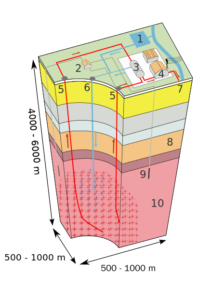 Other obstacles to responding proactively to climate change include: permitting red tape getting renewable power providers tied onto an aging grid, Republicans trying to knee-cap grid upgrades on states’ rights grounds, a shortage of electricians, and NIMBY voters, including hypocritical Democrats, who don’t want wind turbines and solar panels spoiling their views (NYT). Utility-scale renewables are now cheaper than coal if utilities can attain permitting, but renewables have bigger land footprints than coal or nuclear and are often optimal in areas where NIMBYs aren’t used to looking at infrastructure. More nuclear power, wrongly considered renewable but genuinely carbon-free, is also up for debate if we can’t develop renewable energy storage fast enough to get around intermittency issues (downtime when the wind isn’t blowing or Sun not shining), but it’s more expensive than utility-scale renewables, creates radioactive waste, and isn’t 100% safe. We continue to tap carbon-free hydropower and geothermal where possible while researching hydrogen fuel cells, biofuels (e.g. algae), carbon-capture, and fusion and tidal energy. Enhanced geothermal (right) can trigger small quakes, similar to fracking, but it straddles support from environmentalists and fossil-fuel companies that can transition their drilling know-how. Geothermal is “dispatchable” at all times, complimenting intermittent sources well, and is gaining momentum in Texas (the Hill). But the biggest obstacle to tackling climate change is the fossil fuel industry, even as those companies hedge their own bets in favor of the theory.
Other obstacles to responding proactively to climate change include: permitting red tape getting renewable power providers tied onto an aging grid, Republicans trying to knee-cap grid upgrades on states’ rights grounds, a shortage of electricians, and NIMBY voters, including hypocritical Democrats, who don’t want wind turbines and solar panels spoiling their views (NYT). Utility-scale renewables are now cheaper than coal if utilities can attain permitting, but renewables have bigger land footprints than coal or nuclear and are often optimal in areas where NIMBYs aren’t used to looking at infrastructure. More nuclear power, wrongly considered renewable but genuinely carbon-free, is also up for debate if we can’t develop renewable energy storage fast enough to get around intermittency issues (downtime when the wind isn’t blowing or Sun not shining), but it’s more expensive than utility-scale renewables, creates radioactive waste, and isn’t 100% safe. We continue to tap carbon-free hydropower and geothermal where possible while researching hydrogen fuel cells, biofuels (e.g. algae), carbon-capture, and fusion and tidal energy. Enhanced geothermal (right) can trigger small quakes, similar to fracking, but it straddles support from environmentalists and fossil-fuel companies that can transition their drilling know-how. Geothermal is “dispatchable” at all times, complimenting intermittent sources well, and is gaining momentum in Texas (the Hill). But the biggest obstacle to tackling climate change is the fossil fuel industry, even as those companies hedge their own bets in favor of the theory.
In 2021, an undercover reporter recorded ExxonMobil lobbyist Keith McCoy recollecting: “Did we aggressively fight against some of the science? Yes. Did we join some of these ‘shadow groups’ to work against some of the early efforts [on climate]? Yes, that’s true. But there’s nothing illegal about that.” It’s also legal for “big oil” to fund NIMBY efforts. McCoy added that his company only supported a carbon tax because they were confident the public would never support it anyway. He noted that they don’t just influence [buy] Republican politicians: “Joe Manchin (D-WV), I talk to his office every day. He’s the kingmaker on this” [chair of the influential Senate Energy & Natural Resources Committee]. The most corrupt part of America’s political system is lobbying but, because it’s legal, it has the advantage of being transparent. Consequently, good citizenship and voter awareness should involve checking out your representative’s de facto employers on sites like OpenSecrets.org as they, in effect, buy them the office. Oklahoma’s capitol even includes its corporate donors emblazoned around the rim of its rotunda, technically because they contributed to the building’s renovation. Voters matter because they control which politicians get elected. But, after election night, when it gets down to implementing policy, you “pay to play.” Politicians’ votes nearly always align with their donors’ interest, as we first saw in the 1896 election in Chapter 2 and was the case with Manchin’s opposition to renewable energy in infrastructure and spending bills in 2021 (he agreed to a slimmed-down package in 2022). It’s lucrative to chair committees in Congress. Here is his Senate ranking on gifts from oil and gas interests ca. 2021: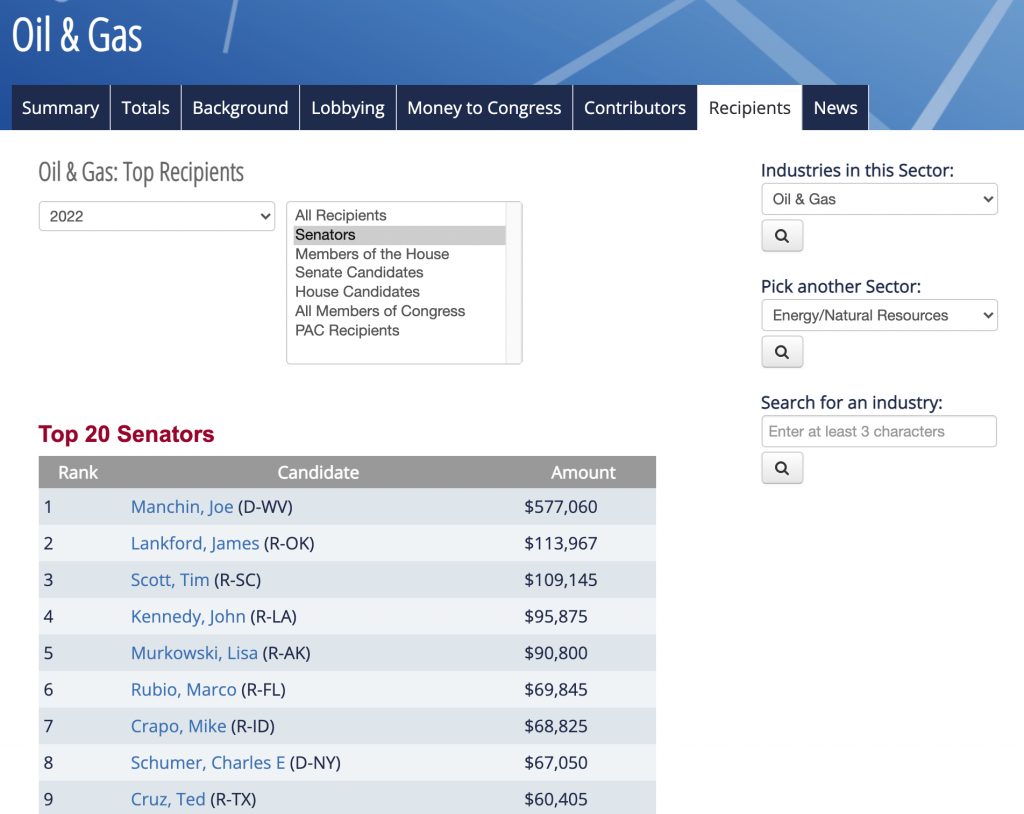
That’s pennies-on-the-dollar for fossil fuel companies if they can stall substantive progress on climate change, giving the big ones more time to hedge bets with their own renewable research, all while greenwashing public relations. Unsurprisingly given his home state and family connections, Manchin was also #1 with the coal industry, edging out Tommy Tuberville (R-AL) and Josh Hawley (R-MO), though that industry has less cash to toss around. You might reasonably wonder why we haven’t outlawed lobbying/campaign contributions. It’s based constitutionally on the First Amendment right to petition the government and it’s impossible to stop anyway, often likened to stopping water from flowing downhill. In their younger years, Bill Gates and Donald Trump used to just write equal checks to both parties to cover their bases, as have countless others. When did this quasi-bribery originate? Undoubtedly about five minutes after Late Neolithic humans invented politics.
On the environment and other issues, Nixon was a Republican president who, despite cantankerous personal relations and his Clean Air Act veto, worked reasonably well with a liberal Congress on legislation. He signed off on Amtrak (a new hybrid public/private passenger train system), signed an executive order expanding employment opportunities for women in the federal government, and called for greater political self-determination among American Indians, signed into law in 1975. Nixon signed a Medicare expansion bill that added coverage for end-stage renal care. He also supported healthcare coverage for the poor in a plan similar to Obamacare (the 2010 Patient Protection & Affordable Healthcare Act), but Nixon’s bill didn’t make it out of Congress. Senator Ted Kennedy (D-MA), John and Bobby’s younger brother, lamented not doing more to back Nixon’s idea but, at the time, he thought a simple, single-payer government option plan was viable so his Democrats defeated a mandate plan that called for those who could afford it to buy private health insurance. Nixon didn’t feel as strongly about these domestic issues one way or another as much as he did foreign policy (détente, Vietnam, Israel, etc.), which is what he meant when he said he wasn’t there “to fix an outhouse in Peoria.”
GOP’s Southern Strategy
Nixon’s key interest in domestic politics, aside from using FBI-directed covert ops like COINTELPRO to infiltrate and disrupt long-hairs, commies, and Blacks, was elections. Without winning he couldn’t get in office and play chess on the Cold War globe with linkage and détente. In 1968, his chief strategist Kevin Phillips masterminded their Southern Strategy to help siphon the old southern Democrats into the Republican’s camp. If the name sounds conspiratorial, keep in mind that every candidate in every election has some strategy for every region and demographic. Phillips coined the term Sun Belt and prophesied an emerging Republican majority in the South and West. Yet, while Barry Goldwater (AZ), Richard Nixon (CA), and Ronald Reagan (CA) were from the West, they earned their electoral votes in the eastern part of the Sunbelt. The Southeast is currently home to ~ 40% of Americans, now nearly 100 million people. One need look no further than the 1964 electoral map to see the seismic shift caused by the Civil Rights Act of that same year — a bill GOP candidate Goldwater opposed despite a majority of Republican senators voting in favor of it. As we saw in Chapter 16, the GOP won the Southeast for the first time ever, defeating a Texas Democrat, no less. FDR, Truman, and Kennedy had avoided being seen as too pro-black in order to retain the Democrats’ “Solid South,” though all three made some headway on civil rights. The Texan LBJ severed the party’s racist ties once and for all but lost the South.
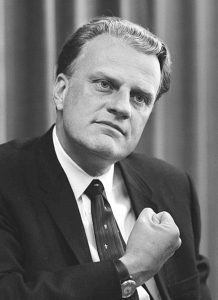 On the face of it, Nixon and Phillips’ Southern Strategy seemed innocuous enough, even progressive, because it called for black voter registration drives, the same kind promoted during the Civil Rights movement. But Nixon’s goal wasn’t to empower Blacks; it was for Blacks to vote Democrat which would, in turn, scare Whites into the arms of the Republicans. They figured that for every African American joining the Democrats — which those that hadn’t already in the 1930s (New Deal) presumably now would with LBJ’s war on racism and poverty — a few Whites would scare off and join the GOP. Phillips wrote, “Whites will desert in droves the minute it becomes a black party.” He told the New York Times Magazine, “The more Negroes who register as Democrats in the South, the sooner the Negrophobe whites will quit the Democrats and become Republicans.” Evangelist Billy Graham (left) campaigned with Nixon, encouraging Southerners to resist racial integration by migrating to the Republican Party.
On the face of it, Nixon and Phillips’ Southern Strategy seemed innocuous enough, even progressive, because it called for black voter registration drives, the same kind promoted during the Civil Rights movement. But Nixon’s goal wasn’t to empower Blacks; it was for Blacks to vote Democrat which would, in turn, scare Whites into the arms of the Republicans. They figured that for every African American joining the Democrats — which those that hadn’t already in the 1930s (New Deal) presumably now would with LBJ’s war on racism and poverty — a few Whites would scare off and join the GOP. Phillips wrote, “Whites will desert in droves the minute it becomes a black party.” He told the New York Times Magazine, “The more Negroes who register as Democrats in the South, the sooner the Negrophobe whites will quit the Democrats and become Republicans.” Evangelist Billy Graham (left) campaigned with Nixon, encouraging Southerners to resist racial integration by migrating to the Republican Party.
Of course, the strategy could cut the other direction, scaring non-racist Whites out of the GOP. Young Hillary Rodham (Clinton), for instance, left the Republican Party for good after attending the 1968 GOP Convention in Miami and objecting to the party’s “veiled” racism. Less famous than the Democrats’ 1968 fiasco in Chicago, the Miami convention included racial unrest but, unlike Chicago, police kept a safe barrier between rioting and the convention center. Celebrities endorsing Nixon included actor John Wayne and basketball center Wilt Chamberlain. Though Chamberlain was African-American, Nixon seemingly chose his VP, Maryland Governor Spiro Agnew, precisely because of Agnew’s confrontational approach to African Americans in Baltimore during the riots following MLK’s assassination four months earlier. While Phillips came to regret his role in the cynical plan and became a liberal analyst and author, there’s no denying the Southern Strategy’s long-term success. But there was a short-term impediment the GOP would need to deal with in 1972: rogue Democrat/independent George Wallace (AIP-AL) was siphoning too many of the sought-after southeastern votes, as seen in this 1968 electoral map (Wallace won 13% of the vote by campaigning to the right of Republicans on race and to the left of Democrats economically):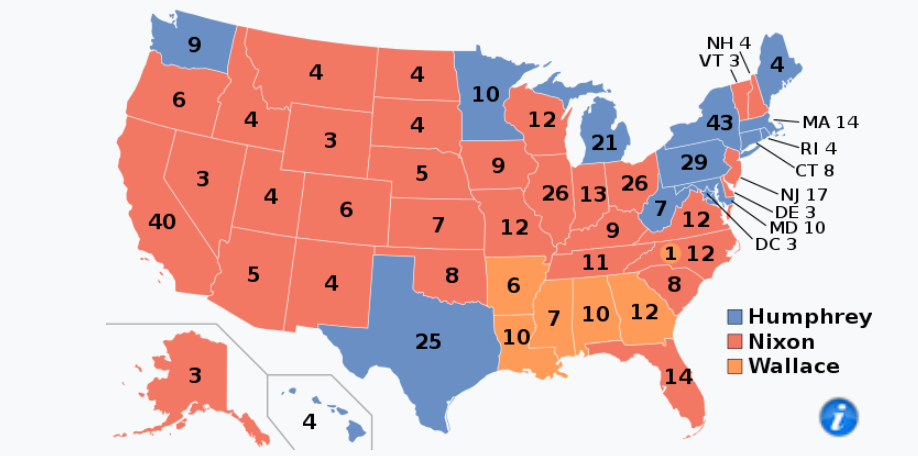
Another big factor in the GOP’s favor was the emergence of prosperous southern suburbanites in the postwar boom, many of whom resisted the Democrats’ tax-and-spend Great Society even if their parents appreciated FDR’s New Deal when they were poor. For a number of reasons, only partly by appealing to white identity, the party of Abraham Lincoln now has a near lock on most of the former Confederacy, with swing states in Florida and some of the Upper South. Conversely, by favoring its progressives and shedding its racists, the party of the former Confederacy dominates the Yankee Northeast. The last vestiges of the old Southern Democrats chaired powerful congressional committees for another half century (e.g., former KKK member Robert Byrd of West Virginia), but today virtually no conservatives vote Democrat. The mainstream “establishment” GOP shed the racism it temporarily capitalized on/tolerated with minorities like Condi Rice, Colin Powell, Ben Carson, Ted Cruz, and Marco Rubio taking an active role. Meanwhile, some voters in the conservative base fight what they perceive to be a rearguard action on behalf of persecuted “Americans” [Whites]. Modern Republican strategists like Stuart Stevens and Rick Wilson thought the party became too openly racist under Trump after Obama’s presidency, prompting them to launch the Lincoln Project, an intra-GOP attempt to restore dignity to the party. Today, high-correlating factors among conservative voters are the belief that Whites are the biggest victims of racial discrimination and, less so, that America persecutes Christians on behalf of Muslims (Atlantic).
As of the 1950s, it wasn’t written in stone that Republicans would temporarily infuse their conservatism with an anti-civil rights orientation, but writers like William F. Buckley, Jr. (pre-1963) and politicians like Goldwater and Reagan found that thinly veiled appeals to states’ rights and nullification of federal power won votes south of the Mason-Dixon line. Everyone understood the subtext, even if it was blended with non-racial small government ideology. For historian and Buckley biographer Sam Tanenhaus, the critical event that galvanized the conservative counter-revolution was racial integration of the public schools after Brown v. Board (1954). The political parties’ shift on race had long-term implications, making it difficult for the Democrats to win in the South and challenging for the GOP to cast a wide demographic net in the 21st century despite minority candidates and modest but growing appeal among minority voters attracted to the party’s cultural conservatism (higher in 2020 than 2016). Democrats Jimmy Carter in 1976 and Bill Clinton in ’92 & ’96, both Southerners themselves, were exceptions to this rule, while Joe Biden won normally red Georgia and Arizona in 2020. Historian Gary Wills put it best in 1975: “American politics is the South’s revenge for the Civil War.”
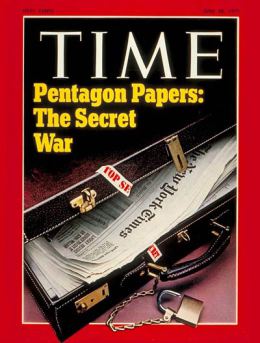 Plugging the Leaks
Plugging the Leaks
What derailed Nixon ultimately was his paranoia, and the event that kicked off his most destructive paranoid phase was the leaking of classified materials by Daniel Ellsberg. Ellsberg was the Julian Assange, Edward Snowden, Reality Winner, Chelsea Manning, or Jack Teixeira of his day, if you’re familiar with recent leakers of classified information. As an employee of the Rand Corporation and CIA, Ellsberg spent time in Vietnam in the early 1960s and started as a true believer in the cause, even distinguishing himself as courageous in covert combat. But Ellsberg turned against the war, partly because of his wife’s influence (they dosed on LSD) and that of journalist Neil Sheehan, and he began to Xerox® classified documents at CIA headquarters. He sold the material to the New York Times and later the Washington Post, Boston Globe, and L.A. Times-Examiner, with the Times and Post first publishing it in serial form, bit-by-bit. The Pentagon Papers revealed nothing incriminating about Nixon’s handling of Vietnam because they stemmed from the Kennedy and Johnson eras. The Pentagon Papers showed that the U.S. was in combat in the early ’60s before the public knew about it, that LBJ chose to escalate months before the Gulf of Tonkin while lying to the public, and, most damning, the CIA’s opinion that the U.S. wasn’t really involved in a civil war so much as it was trying to impose its will on a mostly resistant population. A 1965 letter from Defense Secretary Robert McNamara to LBJ indicated that the real goal wasn’t to “help friend [South Vietnam], but rather to contain China.”
Haverford College physics professor Bill Davidon and Temple religion professor John Raines followed Ellsberg’s lead and that of dodgers who burgled draft boards to disrupt conscription. With the help of a locksmith, their leftist Citizens Commission to Investigate the FBI broke into a low-security Philadelphia FBI office and stole thousands of sensitive documents, including those connected to the forenamed COINTELPRO. As depicted in the documentary 1971 (2014), the papers revealed a trove of illegal surveillance and suppression methods, sullied the reputation of longtime commissioner J. Edgar Hoover, and led to a Congressional inquiry. After 1936, Hoover’s FBI had all but abandoned criminal activity, focusing instead on ferreting out political radicalism. Democratic presidential candidate George McGovern returned the documents the Commission gave him to the FBI, as did two newspapers, but the Washington Post published them. As we’ll see below, this wasn’t the last burglary of the decade or the last time the Post would shake up politics. The Republicans could pick a lock too but, unlike the professors, they got caught.
Despite Nixon’s lack of direct involvement in these leaks, the notion that classified materials could be leaked worried Nixon and Kissinger, especially considering how secretive many of their own actions were. What about Nixon’s treason in sabotaging the 1968 (Paris) peace talks in Vietnam? The FBI and NSA knew about that. After winning the election, the administration had abused the power of the FBI and IRS to harass opponents on their Enemies List, extort donations, and infiltrate the counter-culture and civil rights movement.
Abroad, they’d helped destabilize and overthrow socialist democracies in the Cold War tradition. For instance, after failing to rig elections, Kissinger and the CIA helped upend Chile’s Salvador Allende, to prevent the Soviets from getting a toehold in South America and because Allende’s government threatened the profits of U.S. corporations like Pepsi and ITT. Allende nationalized (took over) U.S. copper mining companies, leading the Nixon administration to cut off credit which, in turn, collapsed the Chilean economy. General Javier Palacios killed Allende (or he shot himself) during a 1973 coup. The resulting right-wing dictatorship of General Augusto Pinochet briefly improved the economy, especially for middle classes, but tortured and murdered over 30k dissidents in the process. With a clean slate to remake a nation in Latin America as it saw fit, the U.S. helped outlaw elections and labor unions and privatized social security and healthcare. The CIA apologized for its involvement years later but denied any direct role. Chile became a democracy in 1990, after Pinochet’s death.
American intervention in Chile was in keeping with Theodore Roosevelt’s 1904 Corollary, and in keeping with Eisenhower’s actions in Guatemala in 1954 on behalf of Chiquita bananas. But, unlike earlier officials, Kissinger also demanded kickbacks on the weapons America sold to the dictatorships that displaced these governments. In Indonesia, for instance, he sold weapons to General Suharto to help quell an independence movement on the island of East Timor and grafted a 10% gratuity for his troubles. Nixon’s administration supported a right-wing military dictatorship in Greece, of all places, the birthplace of democracy. What would the public think if they found out about such actions because of the next Daniel Ellsberg? These weren’t the kinds of things the administration wanted getting out the next time some low-life bureaucrat with access to a copier married a hippie and got conscientious. Nixon and Kissinger resolved to prevent such leaks. They sued the New York Times over the Ellsberg papers but lost the case in the Supreme Court. This led to a more fortress-like mentality in Nixon’s administration. They no longer trusted institutions like the FBI and CIA with their secrets and decided to hire their own team for covert operations. They kept their connections at the Internal Revenue Service, or IRS, in case they needed to sandbag anyone with an audit threat.
Like FDR, Kennedy, and Johnson before him, Nixon kept a reel-to-reel tape recorder going under his desk in the Oval Office because he wanted a record of what people had told him, and he “bugged” his own phone. The tapes reveal, among many other things, a discussion over whether or not they should “neutralize Ellsberg.” They didn’t kill him, but they resolved to “plug any future leaks” by assembling a rogues gallery of “plumbers” to patch them up. Nixon had hoped to weaponize J. Edgar Hoover’s FBI against his enemies but a turf war ensued as Hoover didn’t see tradecraft as something the Executive Branch should be directing; the surveillance state was the FBI’s specialty. Hoover was Nixon’s mentor and friend but had so much dirt on presidents from his own investigations that he was, in some ways, the most powerful man in America. He told incoming presidents: “Only I can protect you from your enemies.” So, Nixon set up his own black-ops group in the White House. The Plumbers were an offshoot of the Committee to Re-Elect the President (CRP, or “CREEP” to Democrats) set up to prepare for the 1972 election. CRP didn’t invent dirty politics – that goes back to the Mesopotamians – but they relished them as a matter of pride. Nixon said of potential Plumbers, “I don’t give a s**t about the law. I just need a sonovab***h who will work his butt off and do it dishonorably.”
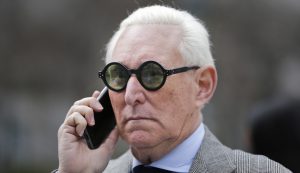 The CRP trained young Republicans on college campuses in self-described “dirty tricks seminars” directed by a young Karl Rove, George W. Bush’s future adviser. One of Nixon’s henchmen, Donald Segretti, coined the phrase ratf**king to describe how they disrupted and infiltrated liberal causes. Segretti and Ronald Ziegler honed their craft in student government at the University of Southern California. Another favorite trick was waving a type of false flag: holding up stupid or offensive signs in street demonstrations on behalf of causes they opposed. Their full repertoire was on display in the 1972 campaign and their range and skill were impressive. If the administration retained any shred of moral credibility up until then, they checked it at the door for what they saw as a pivotal presidential election. CRP worker Roger Stone (right) found work with Trump’s campaign in 2016, serving as the purported go-between with Russian operatives who hacked the Democratic National Committee and Wikileaks. Later he allied with Oath Keepers before the January 6th Insurrection. When Stone smeared Senator Ted Cruz (R-TX) during the 2016 GOP primaries for allegedly having extramarital affairs, Cruz said of Stone that “he’s a man for whom a term was coined for copulating with a rodent,” though really it was Segretti. Stone had Nixon’s likeness tattooed on his upper back.
The CRP trained young Republicans on college campuses in self-described “dirty tricks seminars” directed by a young Karl Rove, George W. Bush’s future adviser. One of Nixon’s henchmen, Donald Segretti, coined the phrase ratf**king to describe how they disrupted and infiltrated liberal causes. Segretti and Ronald Ziegler honed their craft in student government at the University of Southern California. Another favorite trick was waving a type of false flag: holding up stupid or offensive signs in street demonstrations on behalf of causes they opposed. Their full repertoire was on display in the 1972 campaign and their range and skill were impressive. If the administration retained any shred of moral credibility up until then, they checked it at the door for what they saw as a pivotal presidential election. CRP worker Roger Stone (right) found work with Trump’s campaign in 2016, serving as the purported go-between with Russian operatives who hacked the Democratic National Committee and Wikileaks. Later he allied with Oath Keepers before the January 6th Insurrection. When Stone smeared Senator Ted Cruz (R-TX) during the 2016 GOP primaries for allegedly having extramarital affairs, Cruz said of Stone that “he’s a man for whom a term was coined for copulating with a rodent,” though really it was Segretti. Stone had Nixon’s likeness tattooed on his upper back.
Unlike many politicians, who accept bribes from corporations to write favorable laws, Nixon demanded bribes from companies under the threat of thorough IRS audits. Since their victims usually cheated on their taxes, they had no choice but to pay up. Among others, they targeted Cleveland shipping tycoon George Steinbrenner, soon owner of the New York Yankees, who was also convicted for making illegal contributions just to add insult to injury (Ronald Reagan pardoned him in 1989 as one of his last acts in office). On this last item, the modern political parties aren’t necessarily a whole lot different than the CRP. Often when political parties propose a certain law, what they really want is money from whatever group or industry wouldn’t benefit from the law. A sufficient donation will make the law go away. It’s an elaborate way to ask for (blackmail) a donation. What set Nixon apart was the routine use of government agencies or even local police as cudgels to harass people on their enemies list, which in Nixon’s case included all media. From the tapes:
Bob Haldeman, White House Chief of Staff: [Let’s] go after a few media people…harass them…just give them a little trouble.
Nixon: Exactly. Pound these people.
Haldeman: Give ’em something to worry about.
Nixon: It’s routine.
For fans of the First Amendment, the routine comment is the most chilling part.
 1972 Election
1972 Election
The Nixon administration’s biggest threat was Ed Muskie (D-ME), who authored the 1970 Clean Air & Water Act. Muskie’s crimes against liberty are responsible for us being able to breathe, swim, and fish today and he was popular enough at the time to pose a threat to Nixon in the ’72 election. The CRP broke into his office, stole his personal stationery, and sent letters to newspaper editors on it accusing his Democratic opponents of things like being pulled over for drunk driving with prostitutes in the passenger seat. This killed two birds with one stone, making Muskie and his fellow Democrats all look bad at the same time. They hired African Americans to hold up pro-Muskie signs to drive away Whites (a variation on their southern strategy) and cold-called voters on Muskie’s behalf at 1 AM to annoy them. They sent an editorial on his stationary insulting the Canadian population of New Hampshire by calling them Canucks, which caused Muskie to lose that state early in the Democratic primaries. Poor Muskie couldn’t figure out what was going on and finally broke down, nearly crying on camera. Score one for CRP. The left attacked Muskie, too, because they favored South Dakota Senator George McGovern. “Gonzo journalist” Hunter S. Thompson mostly targeted the “venal, predatory bully” Nixon in his Rolling Stone columns — later condensed as Fear & Loathing on the Campaign Trail ’72 — but he planted fake news that Muskie was addicted to Ibogaine, a natural psychedelic. Thompson claimed that he never said Muskie was addicted; “only accurately reported that there had been a rumor…I started the rumor.” This, too, is a time-honored political ploy later institutionalized by Roger Ailes at FOX. Muskie recovered well enough to later serve as Secretary of State under Jimmy Carter, but the one-two punch of dirty tricks from the right and left ruined his chance for the presidency in 1972. Lord knows what these trolls would’ve done with social media and deepfakes.
Next, the CRP set their sights on McGovern (D-SD) and George Wallace, the Alabama governor and feral Democrat who ran for the American Independent Party in 1968. In the competitive sport of manipulating “negrophobes,” the segregationist Wallace diluted the GOP’s Southern Strategy in ’68 by outflanking them and winning most of the Southeast. This time, the CRP threatened to sic the IRS on Wallace’s brother if George didn’t run as a Democrat, which they hoped would steal more votes from the Democrats than if Wallace ran as an independent. Then, an assassin shot Wallace in a Maryland parking lot, paralyzing him from the waist down. Nixon’s men weren’t involved but tapes reveal that immediately upon hearing the news about his friend Wallace, Nixon wanted to plant McGovern literature in the shooter’s house before the FBI got there, to frame the Democrats by association. Again, they could kill two birds with one stone.
After Muskie’s demise and Wallace’s shooting, the main Democratic contender was George McGovern. With the Democrats reeling from their bungling of the Vietnam War under Johnson, they wanted a combat veteran for military credibility, and McGovern had won a Distinguished Flying Cross and Air Medal as a B-24 bomber in WWII (he led 35 missions over Europe without losing a plane). He was liberal by mainstream standards, though. He wanted to grant amnesty to Vietnam draft evaders that had escaped to Canada and the CRP combined that with his pro-choice, pro-marijuana legalization stance into the 3 A’s: Acid, Amnesty and Abortion. They knew that older voters didn’t know the difference between marijuana and LSD.
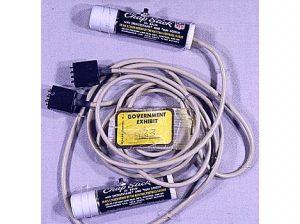 Watergate
Watergate
Nixon faced easy re-election, but his paranoia got the best of him. Shakespeare said it best in Henry IV, Part II: “uneasy lies the head that wears the crown.” Nixon wanted to know what McGovern knew about him, just in case, so he authorized a break-in at the Democratic National Committee’s office. The DNC headquarters were at the Watergate Plaza in Washington, a complex of offices, apartments, and shops along the Potomac River. Nixon’s worst-case scenario was an “October Surprise” whereby, just before the early November elections, Democrats would reveal to the public some of the shenanigans the administration had been up to. To Nixon’s eternal credit, he rejected many of the CRP’s more drastic proposals such as kidnappings, druggings, and bombing think tanks, but it’s very likely (near certain) that he gave the go-ahead to send the Plumbers on this reconnaissance mission. We know from tape recordings, for instance, that Nixon ordered them to “empty the safe” of the centrist/near-left Brookings Institution think-tank in 1971, but also overrode Plumber Charles Colson’s idea to firebomb the building. Subsequent investigations never proved decisively that Nixon himself authorized the Watergate burglary. Either way, the actual Watergate break-in crime was minor, but Nixon committed several felonies trying to cover it up and established a track record of unrepentant criminality before that with the establishment of his black-ops Plumbers.
In an old-school version of the 2016 Russian hack of DNC email, Nixon’s men set up a room at the Howard Johnson’s Motor Lodge across the street from DNC headquarters at the Watergate Complex, plotting to wiretap (“bug”) and monitor the Democrats as part of the CRP’s Operation Gemstone. Alone among presidents, Nixon had staff commit crimes with the word operation in front of them, like the Normandy Invasion. The Plumbers broke in once and tapped the phones, then went back three weeks later for files, in June 1972. When they broke in the first time, they duct-taped open a normally locked door from the hallway to the stairwell, grabbing the attention of a security guard who removed the tape. They did the same thing the second time and the same guard noticed again, leading to their arrest. The infamous door is on display at the Newseum in Washington. Modern cyber-attacks don’t have duct tape to worry about or wiretaps jury-rigged with ChapStick® (upper left), but they also leave a trail of evidence (Pegasus spyware is a current exception, but it’s expensive).
Two young reporters for the Washington Post, Bob Woodward (Republican) and Carl Bernstein (Democrat), covered the seemingly routine arraignment of the burglars, who were mostly Cuban nationals. They noticed they lacked cash, the presumptive motive for such a break-in, and had tear gas pens and “little black books” with addresses of men connected to Nixon. That was an eyebrow-raiser, to say the least. One of the burglars, James McCord, was a former CIA agent (electronics expert) and two of the others had the phone number of E. Howard Hunt, another former CIA officer who then worked in the Nixon White House. It said “W-House” next to Hunt’s name. Hunt had been the Plumber in charge of breaking into Daniel Ellsberg’s psychiatrist’s office in Los Angeles to dig up dirt on him and of trying to plant McGovern literature in the Milwaukee home of George Wallace’s would-be assassin Arthur Bremer. The Post reporters called Hunt to ask him why his name was in the address books of the burglars. After a long silence, he said “uh-oh,” hung up and skipped town. There were so many connections to the CIA that, at first, investigators thought the Watergate break-in was a CIA operation when really it was Nixon’s own Plumbers.
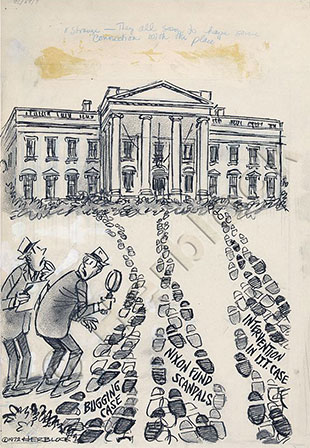 Woodward and Bernstein investigated the story as an anonymous source gave them leads. Still, the reporters were slower to publicly trace the break-in back to Nixon than their Post colleague Herb Block, whose cartoons (left) raised the possibility of a White House connection less than a week after the burglary. Block, who coined the term McCarthyism in 1950 (Chapter 15), didn’t have a shred of evidence, but his gut instinct, correctly and luckily for him, told him that Nixon was behind it.
Woodward and Bernstein investigated the story as an anonymous source gave them leads. Still, the reporters were slower to publicly trace the break-in back to Nixon than their Post colleague Herb Block, whose cartoons (left) raised the possibility of a White House connection less than a week after the burglary. Block, who coined the term McCarthyism in 1950 (Chapter 15), didn’t have a shred of evidence, but his gut instinct, correctly and luckily for him, told him that Nixon was behind it.
At first, the anonymous source would only meet Woodward and Bernstein in a dark parking ramp in Rosslyn, Virginia, standing over in the shadows. He gave them tips like “follow the money” as the administration was funding CRP partially with laundered Mafia drug money. The reporters focused on this secret slush fund and nicknamed their source “Deep Throat,” from the title of a recent porn movie. When the young newshounds told their editor Ben Bradlee about these leads, he wasn’t very impressed with their coy source. After all, Block’s cartoons were one thing; but, if his newspaper printed stories accusing the President of the United States of felonious crimes, or being connected to them, they couldn’t afford to get the story wrong. This was back when most people got real news from reputable sources, dug up by real reporters. A few years later, Bernstein and Woodward’s investigation was the subject of a best-selling book and movie All the President’s Men (1976) starring Dustin Hoffman and Robert Redford. But months before anyone was following their story, Nixon crushed McGovern in the 1972 election, winning electoral votes within the states 49-1. The Democrats had no October Surprise and the Plumbers should’ve just left well enough alone.
News of the break-in actually broke before the election but, as seen with Nixon’s resounding victory, the story hadn’t gained much traction and the public saw it as a red herring or witchhunt. Ted Kennedy (D-MA) led the Senate Judiciary Committee but had skeletons in his own closet that likely made him fear Nixon’s retaliation (see optional article below). Woodward and Bernstein persisted after the election, though, even after the New York Times and other papers dropped the story and they eventually got to know Deep Throat. He was Mark Felt, the second-in-command at the FBI who was angry that Nixon passed him over for the top job to replace J. Edgar Hoover, instead installing an unqualified stooge, L. Patrick Gray, that he hoped would shield him from the law. Soon our old friend CBS anchorman Walter Cronkite began taking notice of these stories in the back pages of the Post. He “gave them legs,” in journalists’ lingo, by mentioning them on the national news, leading to the Watergate Crisis. White House Press Secretary Ron Ziegler was angry with the Post and CBS, calling their coverage “shoddy journalism…shabby journalism.” Congressional Democrats formed a bipartisan panel to investigate whether or not the Watergate break-in had any connection to the White House. It did and the tape recorder Nixon insisted on running under his desk revealed plenty about the bribes (hush money) and threats the administration undertook to snuff out the story. They were also bugging and trying to sabotage the Washington Post since they were the only paper covering the story after the election. The tapes reveal that Nixon’s inner circle suspected there was a leak in the FBI and that it might be Felt, but didn’t want to out him for fear that he’d tell reporters even more than they already knew.
Nixon committed his own crimes during this cover-up, not the break-in. News coverage brought the terms bug and wiretap into mainstream jargon, but the biggest story was that the Oval Office had bugged itself. By running JFK’s old reel-to-reel to gather evidence on others, Nixon baited his own trap. Under oath, the Plumbers kept their lips sealed in the congressional hearings, but then White House counsel John Dean, the “master manipulator of the cover-up,” broke down and the floodgates opened. Suspecting that his superiors were setting him up as a scapegoat, Dean cut a plea deal with a reduced prison sentence and sang for seven hours straight about the Nixon administration’s criminality. It was must-see TV for Nixon-haters. Then, when White House assistant Alexander Butterfield mentioned the tape recorder, the Committee (and the public) demanded the tapes. Nixon refused to hand them over, instead providing some redacted typed transcripts edited with a black magic marker.
At first, Nixon had allies in the Judiciary, partly because former Attorney General John Mitchell (above, right) was overseeing Nixon’s campaign, but Mitchell was sentenced to prison for obstruction of justice. His successor, Richard Kleindienst, was convicted of perjury, the only time an active Attorney General has been convicted of a crime. Vacationing in California when news of the burglary broke, Mitchell’s wife Martha (above) recognized the name of burglar James McCord as an associate of the Plumbers. Since the gregarious Arkansan known as the “mouth of the South” had a reputation for loose lips when drinking, Plumbers ripped her hotel phone out of the wall, locked her up, and medicated her to keep her quiet. The man who sequestered her, Steve King, became Trump’s ambassador to the Czech Republic in 2017. Since Republicans then smeared her as being crazy upon release for suggesting such a connection between Watergate and the Nixon administration, the Martha Mitchell Effect is shorthand for when psychiatrists or psychologists diagnose someone as mentally ill for thinking something they’re actually right about, a professional variation of gaslighting.
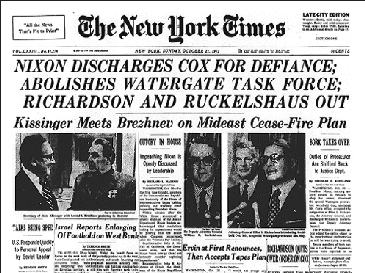
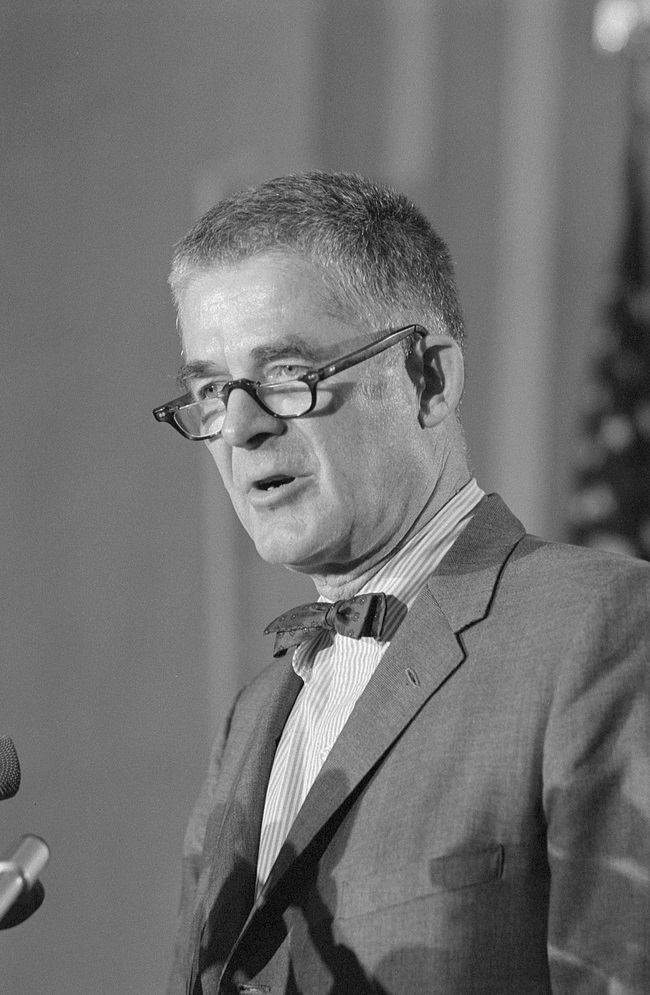 According to journalist John Farrell and evangelist Billy Graham, Nixon was drinking more heavily and starting to melt down because special prosecutor Archibald Cox was expanding the investigation beyond Watergate into other white-collar crimes. In the infamous Saturday Night Massacre, Nixon tried to force the resignation of those in the Justice Department that demanded the actual tapes and to get his AG (one of Kleindienst’s successors, Elliot Richardson) and Deputy AG to fire Cox (right) but they refused and resigned. The Justice Department’s Special Prosecution office briefly closed and Ziegler declared the investigation over, but the FBI sealed the office and secured the files and Nixon named Leon Jaworski as Special Prosecutor to replace Cox. Amidst this constitutional crisis, that TV commentators were comparing to the Nazi Reichstag fire and describing as a coup d’état, Nixon’s popularity was still fairly strong among Republican voters but 44% of Americans favored impeachment. But middle American newspapers and TIME magazine (in its first-ever editorial) called for Nixon’s resignation.
According to journalist John Farrell and evangelist Billy Graham, Nixon was drinking more heavily and starting to melt down because special prosecutor Archibald Cox was expanding the investigation beyond Watergate into other white-collar crimes. In the infamous Saturday Night Massacre, Nixon tried to force the resignation of those in the Justice Department that demanded the actual tapes and to get his AG (one of Kleindienst’s successors, Elliot Richardson) and Deputy AG to fire Cox (right) but they refused and resigned. The Justice Department’s Special Prosecution office briefly closed and Ziegler declared the investigation over, but the FBI sealed the office and secured the files and Nixon named Leon Jaworski as Special Prosecutor to replace Cox. Amidst this constitutional crisis, that TV commentators were comparing to the Nazi Reichstag fire and describing as a coup d’état, Nixon’s popularity was still fairly strong among Republican voters but 44% of Americans favored impeachment. But middle American newspapers and TIME magazine (in its first-ever editorial) called for Nixon’s resignation.
The Justice Department is housed in the executive, not judicial, branch though, in theory, it’s still independent of the executive. Unless impeached, the president can fire many of his own investigators (but not a lead Special Counsel) and pardon anyone convicted of federal (not state) crimes (Article II, Section II), at least up to the point that it’s politically sustainable. The Justice Department, in turn, hasn’t indicted any sitting presidents, at least so far, referring presidential crimes instead to the House of Representatives to consider impeachment. The idea that presidents potentially oversee their own investigations is an obvious conflict of interest accidentally built into our Constitution, as pointed out in the quote at the top of our chapter by George Mason, the most unsung of the key Founding Fathers. And, if presidents can’t be indicted by the Justice Department, then it’s imperative that the House of Representatives see the full, unredacted results of any criminal investigations or whistleblower complaints; otherwise, there’s no check on the president.
After the Saturday Night Massacre, the Congressional House Judiciary Committee demanded the tapes and District Judge John Sirica granted Leon Jaworski’s grand jury access to the tapes but not Congress, apparently citing executive privilege though that wasn’t clearly resolved before Nixon left office. Nixon’s lawyers reasoned that, since Thomas Jefferson had technically broken the law by tampering with the Aaron Burr Trial in 1807 and never gone to jail or turned over key evidence, so too all presidents thereafter were immune from the law (i.e., executive privilege). Nixon also leaned on Abraham Lincoln’s suspension of habeas corpus during the Civil War. However, unlike the Civil War, Watergate was a minor self-inflicted crisis and Sirica called Nixon’s appeal to Jefferson “false, arrogant, and near-sighted.” The case fast-tracked to the Supreme Court, where justices shot down Nixon’s appeal for executive privilege 8-0 in Nixon v. United States (1974).
The FBI sealed off the White House and seized the tapes. Nixon’s secretary managed to erase a lot of the most sensitive material, but even the remainder was more than enough to incriminate Nixon and his Republican support mostly eroded. On the “smoking gun tape” from June 23, 1972, Nixon and Chief of Staff H.R. Haldeman conspired to obstruct the investigation into the Watergate break-in and discussed using the CIA to stop the FBI from following the money trail that would’ve tied the White House to the break-in that Haldeman helped organize. Haldeman said, “every president needs an S.O.B. I’m Nixon’s S.O.B.” After reading the transcripts, the Chicago Tribune opined of Nixon: “He is humorless to the point of being inhumane. He is devious. He is vacillating. He is profane. He is willing to be led. He displays dismaying gaps of knowledge. He is suspicious of his staff. His loyalty is minimal.” Jaworski forwarded his full, un-redacted Road Map report to Congress, where impeachment proceedings began in the House of Representatives based on three articles: obstruction of justice, conspiracy, and perjury. Influential Republicans like Barry Goldwater made their way to the White House to tell Nixon to hit the road before he became a bigger embarrassment. He resigned before impeachment proceedings worked their way from the House to the Senate trial and likely conviction. He moved back to San Clemente, California, allowing he’d made mistakes but reiterating what he’d said the previous year, that he was “not a crook.” In an epic case of shooting the messenger, Nixon later said the “real villain” was Walter Cronkite for breaking the story. While not indicted, Nixon was named as an “un-indicted co-conspirator.”
The Watergate investigation also revealed that over 30 corporations, including American Airlines, made illegal contributions in exchange for subsidies, leading to campaign finance reform laws subsequently undermined by the 2010 Citizens United case. According to a secret file submitted to the LBJ Library in Austin by Johnson aide Walt Rostow, Nixon contacted LBJ as the Watergate scandal was unfolding, hoping the retired president could use his influence to stop the probe. He tried to blackmail LBJ into helping, or else Nixon would reveal that he knew Johnson was wiretapping him in the run-up to the 1968 election. LBJ was infuriated, still blaming Nixon for sabotaging the Vietnamese peace talks that year — the reason LBJ was tapping him to start with — and ruining his legacy. Two days later Johnson died of a heart attack. The tapes also included Nixon and Billy Graham grousing about Jewish influence in the media, which embarrassed Graham as he was trying to build ecumenical alliances. At first, Graham tried damage control with Watergate, beseeching the Southern Baptist Convention in Dallas to “not go around being so self-righteous…there are bad people in both parties,” but he eventually realized that his friendship undermined his credibility and broke with Nixon.
When Nixon’s VP Spiro Agnew went to jail for extortion, bribery, and tax evasion, Nixon replaced him with Gerald Ford, a soft-spoken, straightforward Senator from Michigan, best known for serving on the Warren Commission to investigate the Kennedy assassination and being a star college football lineman at Michigan in the 1930s. Ford joked that he “got [his] job through the Washington Post,” referring not to their classified ads but to the Watergate investigation. He brought on Donald Rumsfeld as Secretary of Defense and 33-year-old Dick Cheney as White House Chief of Staff (right), diminishing the role of Secretary of State Kissinger. The two men later served as George W. Bush’s Defense Secretary and VP, respectively, spearheading the 2003 Iraq invasion.
Arguing that the country needed to move on and not wallow in the muck of Watergate, Ford pardoned Nixon. Most of the rest of Nixon’s administration ended up in “Club Feds:” high-class minimum-security, fenced-in, prison resorts for rich, white guys that, unfortunately for unscrupulous Wall Street traders, no longer exist. Nixon’s former “hatchet man” Chuck Colson, mastermind of the unrealized plot to blow-up the Brookings Institution, converted to Christianity in 1973 and founded Prison Fellowship, the biggest outreach group for inmates and their families. Chief Plumber Gordon Liddy parlayed his crimes into a successful career as a right-wing radio and cable personality. Roger Stone said, with Nixon, that he was officially a scheduler by day, but “By night, I [was] trafficking in the black arts.” When he worked for Trump later, Stone was banned from CNN and MSNBC after calling one commentator an “entitled diva bitch” and imagined her “killing herself,” while referring to another as a “stupid Negro.” Later, pundits attached the –gate suffix to other controversies, like Irangate, Monicagate, Gamergate, Spygate, Deflategate, Pizzagate, and Russiagate (or Kremlingate), just to name a few.
Watergate is a good example of how historiography (historical study and interpretation) is an ever-changing, ongoing argument. The GOP distanced itself from Nixon for the next forty years, framing him as an outlier. But Donald Trump, a friend and admirer, tried to restore his reputation and diminish his crimes as best as he could, arguing that Hillary Clinton’s use of a personal email server as Secretary of State was “magnitudes worse than Watergate” (see optional article below). Unlike Nixon, Trump’s lawyers, including Democrat Alan Dershowitz, successfully argued that a sitting president has legal immunity while in office, especially if his crimes are on behalf of getting re-elected (Wiki). Unlike Nixon, Trump was able to install a like-minded attorney general, William Barr, who went along with not pursuing obstruction of justice charges in the Russia investigation but drew the line on Trump’s attempt to overturn the 2020 election. But, unlike Nixon, public knowledge of that attempt, such as the January 6th Hearings and Raffensperger Audio, reinforced rather than undermined Trump’s popularity. For Trump, Nixon’s mistakes weren’t his crimes but rather getting caught with the tape recorder and giving up too easily: “He left. I don’t leave.”
Foreign Assassinations & Church Committee Hearings
One of Gerald Ford’s lasting legacies was to outlaw, by executive order, American political assassinations of foreign leaders. Ford had not only investigated the Kennedy killing but was shot at twice himself, once by deranged Manson girl Squeaky Fromme. Ronald Reagan, who was shot in 1981, re-upped the order (more recently, the U.S. killed Saddam Hussein after he was deposed and participated in the assassination of Muammar Gaddafi). Ford’s order coincided with the [Senator Frank] Church Committee Hearings on the CIA’s role during the Cold War. Revelations that came about during Watergate led to further hearings on secret CIA activities like the Rockefeller Commission (1975) and Church’s broader hearings, one of Watergate’s biggest legacies. It was during the 1975 Church hearings, for instance, that Americans learned of foreign leaders the U.S. had killed like Patrice Lumumba in the Democratic Republic of the Congo for leaning too far to the left and Rafael Trujillo in the Dominican Republic in 1961 for embarrassing the U.S. by cracking down too hard on the left. Plumber Howard Hunt revealed that, when working for the CIA during Lyndon Johnson’s administration, he’d infiltrated Barry Goldwater’s campaign, though that election was so lopsided it likely had no effect (Politico). Still, for a sitting president to use the CIA to influence his own election is a serious smirch on LBJ’s reputation, even if it wasn’t decisive in that case. The Church hearings, along with a second investigation into the Kennedy assassination, exposed JFK’s plan to hire the Mafia to kill Cuban leader Fidel Castro. The Mafia killed several potential witnesses, including ex-Teamster boss Jimmy Hoffa, with further knowledge of mob ties to the government and Nixon administration as the Church Hearings unfolded. Nixon Plumbers tapped the Mafia for hush money during the Watergate cover-up while Nixon pardoned the popular Hoffa to win blue-collar votes. The Church Hearings also revealed that J. Edgar Hoover’s FBI recorded Martin Luther King, Jr. having extramarital affairs and tried to use the tapes to blackmail MLK into committing suicide or they would play them to his wife, Coretta Scott.
Another bombshell came two years later, in 1977, with Edward Kennedy’s Commission’s CIA hearings concerning MKUltra, a project launched in 1953 devoted to exotic and sinister methods of thought control similar to that portrayed in the Cold War classic book and movie The Manchurian Candidate (1962). The CIA incinerated most of their documents but, through the 1966 Freedom of Information Act, journalist John Marks discovered a financial paper trail. Marks and fellow journalist Seymour Hersh, who exposed the My Lai Massacre in Vietnam, inspired the Church Committee Hearings.
Originally, the CIA drew on the expertise of Nazis versed in torture and brainwashing as a spinoff of Operation Paperclip, the program used to recruit Nazi rocket scientists after WWII. Though secretive, MKUltra cut-out groups (sub-contractors) included universities, prisons, and pharmaceutical companies, some of whom didn’t realize that their work was connected to the CIA. For LSD experiments, subjects were a mix of volunteers (e.g., Beatnik author Ken Kesey) and unwitting Americans and Canadians. Stories of hypnosis, truth serums, verbal and sexual abuse, sensory deprivation, electroconvulsive therapy, and isolation — some true, some conjectural, some exaggerated — have fanned rumor mills ever since. While we’ll probably never ferret out the details, we can safely say that this exploitative, decades-long waste of taxpayer dollars illustrates the lengths America went to confronting communism and the dangers of unchecked power within covert intelligence agencies.
Conclusion
The early 1970s were a carryover of the tumultuous 1960s. Actually, the “Sixties” didn’t go from 1960-1969; they went from about Kennedy’s assassination in November 1963 to around 1974-75. There were ongoing liberation movements, New Age religions, fitness and nutrition crazes, the continuation of drugs, sex, and rock-n-roll, and conservative counter-reactions like Phyllis Schlafly and Anita Bryant campaigning against career women and homosexuality, respectively. In an outrageous application of zero-sum thinking, Schlafley falsely but effectively argued that the proposed ERA Amendment would coerce housewives into front-line military combat and lesbianism while their kids were locked in government daycare. Note: Zero-sum isn’t always a fallacy. With balanced budgets, for instance, we can’t offer any group a tax break without charging everyone else more.
No one had coined the term culture wars yet, but our current version commenced in the 1960s and ’70s. The 1970s were the first decade of economic downturn since WWII, with a toxic mix of high unemployment and inflation. The loss in Vietnam contributed to inflation by ballooning the budget deficit and left Americans disgruntled. The space program lost its luster and now the public was faced with the fact they’d elected a cynical crook as their president in the name of “law and order.”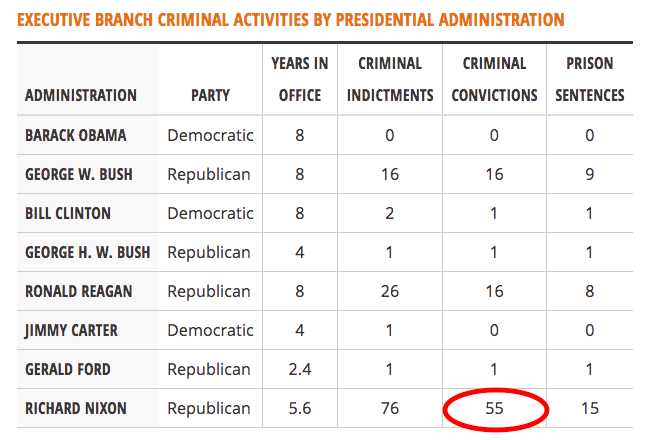
In some ways, this loss of innocence was helpful because it showed the free press in action and made the electorate less naïve about politics. I’m presuming, reader, that when you learned a few paragraphs ago that Attorney General Mitchell went to prison, you didn’t faint or even gasp, even though he had been the highest presiding law officer in the country. But Watergate also jaded the public and that dovetailed with the Reagan Revolution’s anti-government ideology of the 1980s to give many Americans an overly conspiratorial and negative view of politics. In that way, Watergate might have ironically damaged the Democrats more than Nixon’s Republicans. It’s not healthy for citizens in a democracy to either have full faith or fully lack faith in their leaders. In neither case do voters hold politicians accountable or stay engaged themselves.
If it’s true that you can’t really succeed in politics at the national level without being somewhat of an egotistical, power-hungry, conniving scoundrel, then voters should have a realistic notion of their leaders’ impurities. Henry Kissinger described Nixon as a man of “warring personalities — one reflective and philosophical, another impulsive and erratic.” But voters should also understand that most politicians get into politics to serve their country. Richard Nixon was no exception. The irony of committing felonies on behalf of law and order was lost on his administration, but their criminality resulted from a genuine if delusional belief that the country would collapse if Democrats came into power. They never followed through on the most violent proposals, but they indulged in numerous dirty tricks throughout the Democratic primaries to get the candidate they wanted to run against (McGovern), helped themselves to a sneak-and-peek in the Democratic headquarters, then panicked when word got out and bribed and blackmailed people during the cover-up. They weren’t there to plunder or steal from the people or deliberately destroy the public’s trust in government, but morally they lost their compass by wandering further down the ends-justify-the-means trail than any administration in American history up until that time.
That says more about how fortunate Americans have been in their brief history than it does about how corrupt Nixon’s administration was. We’re lucky there are leaders out there to step up and run the place because that’s what allows the rest of us who are too weak, selfish, or lazy to lead, to instead sit on the sidelines and complain about their imperfections, or ignore politics altogether. If you hate politics and think they’re boring, keep in mind that you only have the luxury of being apolitical because of how well, not how poorly, the American system has served you in the big scheme of things. Were he alive today, I’m sure the King would agree.
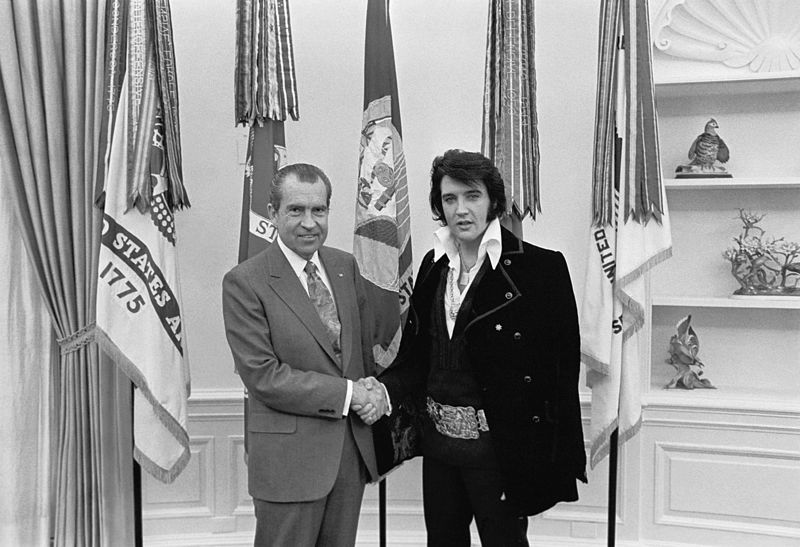
Elvis Presley & Richard Nixon in the Oval Office, 1970, Ironically Promoting Drug Enforcement Despite The King’s Own Addiction
Optional Reading:
Anne Applebaum, “Netanyahu’s Attack On Democracy Left Israel Unprepared,” Atlantic (10.21.23)
Gary Bass, “The People Who Didn’t Matter To Henry Kissinger,” Atlantic (11.29.23)
Cory Bennett, “How Donald Trump Has Redefined Watergate,” Politico Magazine (7.5.20)
John Farrell, “Was Nixon’s Reelection Kennedy’s Fault?” Politico Magazine (10.3.22)
Rogé Karma, “Why The U.S. Is Pumping More Oil Than Any Country In History,” Atlantic (12.23)
